- Paddle Board


What Is the Average Speed of a Sailboat (Plus Its Top Speed)?
Sailing is a popular hobby and sport enjoyed by many enthusiasts around the world. The beauty of sailing lies in the challenge of mastering the wind and currents to move a boat forward. One of the fascinating aspects of sailing is its speed. Sailboats can move at varying speeds, depending on several factors. In this article, we will dive into the average and top speeds of sailboats and explore the techniques and strategies to increase sailboat speed.
Quick Facts
| Topic | Details |
|---|---|
| Sailboat Speed Dynamics | Determined by points of sail, wind direction, and boat design. |
| Factors Affecting Speed | Wind speed, sail area, boat size and weight, water friction, and boat design. |
| Measuring Speed | Via GPS, handheld speedometers, speed logs, timed performance, or wind instruments. |
| Types of Sailboats | Dinghies, Catamarans, Monohulls, Cruising Sailboats, and Racing Sailboats. |
| Average Speed (Dinghies) | 8-15 knots (9-17 mph). |
| Average Speed (Catamarans) | 15-25 knots (17-29 mph). |
| Average Speed (Monohulls) | 5-20 knots (6-23 mph). |
| Average Speed (Cruising Sailboats) | 5-15 knots (6-17 mph). |
| Average Speed (Racing Sailboats) | 20-30 knots (23-35 mph). |
| Increasing Speed | Optimizing sail trim, balancing the boat, reducing drag, and proper maintenance. |
| Sailboat Top Speeds | Influenced by wind speed, boat size and weight, sail area, and water conditions. |
| World Speed Record | Held by Sailrocket 2 at 68 mph. |
| Pushing to Limits | Requires experience, knowledge, skill, understanding of wind and water conditions, and prioritizing safety. |
Understanding Sailboat Speeds
Before delving into the average and top speeds of sailboats, you need to understand the dynamics of sailboat speeds. Sailboat speeds can be determined by the points of sail, wind direction, and boat design. Points of sail refer to the various angles at which a boat can sail in relation to the wind. These angles include upwind, close-hauled, beam reach, broad reach, and downwind (also called a run). Wind direction plays a crucial role in determining sailboat speed. A tailwind is usually faster than a headwind. The boat design also determines the speed potential of a sailboat.
When sailing upwind, sailboats move slower because they are fighting against the wind. Close-hauled sailing is the point of sail where the boat is sailing as close to the wind as possible. It is the slowest point of sail, as the boat is sailing against the wind. Beam reach sailing is when the boat is sailing perpendicular to the wind. It is faster than close-hauled sailing but slower than broad reach sailing. Broad reach sailing is when the boat is sailing with the wind behind it. It is faster than beam reach sailing but slower than downwind sailing. Downwind sailing is when the boat is sailing with the wind directly behind it. It is the fastest point of sail, as the boat is moving with the wind.
Factors Affecting Sailboat Speed
Several factors influence the speed of sailboats. Wind speed is the most significant factor affecting sailboat speed. The bigger the sails, the more power a sailboat has to move faster. Sail area also plays a crucial role in determining sailboat speed. A larger sail area means more power to move the boat. Boat size and weight also come into play, as larger boats require more power to move at faster speeds. Water friction is another critical factor that affects speed. Friction between the hull and the water can slow down a sailboat, but optimized boat design can minimize this effect.
Boat design is essential in determining sailboat speed. The boat’s hull shape, keel design, and rigging all play a role in how fast the boat can sail. The hull shape affects how the boat moves through the water, and a streamlined shape can reduce water resistance and increase speed. The keel design affects the boat’s stability and maneuverability, which can affect speed. Rigging, including the mast and sails, also plays a crucial role in sailboat speed. A well-designed rig can help the boat capture more wind and move faster.
Measuring Sailboat Speed
There are various ways to measure sailboat speed. The most common method is the use of a GPS or handheld speedometer. GPS offers accurate speed readings, while handheld speedometers are affordable and provide basic speed readings. In sailboat racing, measurements are done using speed logs attached to the boat’s hull or through timed performance over a specific distance. Sailboat speed can also be measured using wind instruments, which measure the wind speed and direction and calculate the boat’s speed based on that information.
Sailboat speed is affected by various factors, including wind speed, sail area, boat size and weight, water friction, and boat design. Understanding the points of sail and how wind direction affects sailboat speed is essential in determining how fast a sailboat can go. Measuring sailboat speed can be done using various methods, including GPS, handheld speedometers, speed logs, timed performance, and wind instruments.

Types of Sailboats and Their Average Speeds
Sailboats come in different designs, shapes, and sizes, each with its unique features and capabilities. Whether you are a seasoned sailor or a beginner, choosing the right sailboat type can make all the difference in your sailing experience. Here are some popular sailboat types and their average speeds.
Dinghies are small sailboats primarily used for recreational sailing. These boats are easy to handle and maneuver, making them a popular choice for beginners. Dinghies usually have a single sail, which limits their speed potential. However, their lightweight design allows them to move swiftly through the water. On average, dinghies can move at speeds of 8-15 knots (9-17 mph).
One of the most popular dinghy sailboats is the Laser, which has been an Olympic class boat since 1996. The Laser is a one-design boat, meaning that all boats are built to the same specifications, ensuring fair competition. The Laser is known for its speed and agility, making it a favorite among sailors around the world.
Catamarans are two-hulled sailboats that have a wide beam, making them stable and fast. These sailboats can achieve high speeds and are popular for racing and cruising. Catamarans have a unique design that allows them to sail close to the wind, making them efficient and fast. On average, catamarans can move at speeds of 15-25 knots (17-29 mph).
The Hobie Cat is one of the most popular catamarans in the world. The Hobie Cat is a small, beach-launched catamaran that is perfect for recreational sailing. The boat’s lightweight design allows it to move quickly through the water, and its unique trampoline design makes it comfortable to sail.
Monohulls are the most common sailboat type. These boats have a single hull and can range from small recreational boats to large racing sailboats. Monohulls are versatile boats that can be used for cruising, racing, and day sailing. The average speed range of monohulls is 5-20 knots (6-23 mph).
The J/Boat is a popular monohull sailboat that is known for its speed and performance. The J/Boat is a racing sailboat that has won numerous regattas and championships around the world. The boat’s lightweight design and high-tech features make it a favorite among competitive sailors.
Cruising Sailboats
Cruising boats are designed for comfort and leisurely sailing. They are usually larger and heavier than other sailboat types and can accommodate large crews. Cruising sailboats are perfect for long-distance sailing and exploring new destinations. The average speed range of cruising sailboats is 5-15 knots (6-17 mph).
The Beneteau Oceanis is a popular cruising sailboat that is known for its comfort and luxury. The Oceanis has a spacious interior and can accommodate large crews, making it perfect for extended sailing trips. The boat’s sturdy design and reliable performance make it a favorite among cruising sailors.
Racing Sailboats
Racing sailboats are designed with performance in mind. These boats are usually lightweight and have a larger sail area than recreational sailboats, allowing them to reach high speeds. Racing sailboats are perfect for competitive sailors who want to push their limits and test their skills. The average speed range of racing sailboats is 20-30 knots (23-35 mph).
The Melges 24 is a popular racing sailboat that is known for its speed and agility. The Melges 24 is a one-design boat that is used in numerous regattas and championships around the world. The boat’s lightweight design and high-tech features make it a favorite among competitive sailors.
How to Increase Your Sailboat’s Speed
There is nothing quite like the feeling of sailing at high speeds, with the wind in your hair and the sun on your face. However, achieving maximum speed on a sailboat requires more than just a favorable wind. In this article, we will explore some tips and techniques to help you increase your sailboat’s speed and performance.
Optimizing Sail Trim
Sail trim refers to the setting of the sails in the most efficient way possible to harness the wind’s power and produce maximum speed. Proper sail trim can also improve the boat’s stability and balance. Optimizing sail trim involves adjusting the sails to the correct shape, angle, and tension.
One way to achieve the correct sail trim is to use telltales, which are small pieces of yarn or ribbon attached to the sail. By observing the telltales, you can adjust the sail’s position to achieve the optimal angle and tension. It is also essential to adjust the sails according to the wind conditions. For example, in light winds, the sails should be fuller, while in strong winds, the sails should be flatter.
Balancing the Boat
A balanced boat helps the sailboat move smoothly and efficiently through the water. Balancing the boat involves shifting the crew to counterbalance the forces applied on the sailboat, such as wind gusts and waves. Proper weight positioning can reduce drag and maximize boat performance.
When sailing upwind, it is essential to keep the weight forward to prevent the boat from heeling too much. Conversely, when sailing downwind, it is best to keep the weight aft to prevent the bow from digging into the water. Additionally, it is crucial to keep the weight evenly distributed from side to side to maintain the boat’s balance.
Reducing Drag
Drag is the resistance a sailboat encounters as it moves through the water. Reducing drag can increase speed potential. Techniques to reduce drag include using smooth hull coatings, eliminating unnecessary weight, and keeping the boat clean and free of barnacles and other marine growth.
Another way to reduce drag is to minimize the amount of exposed surface area on the boat. This can be achieved by using a smaller headsail or reefing the mainsail in heavy winds. It is also important to keep the sails properly trimmed, as a poorly trimmed sail can create unnecessary drag.
Proper Maintenance
A well-maintained sailboat operates at its full potential and can achieve higher speeds. Proper maintenance involves regular cleaning, lubrication, and replacement of worn-out parts. It is also essential to keep the sails and rigging in good condition.
Inspect the sails regularly for any signs of wear and tear, such as frayed edges or holes. Replace any damaged sails promptly. Similarly, inspect the rigging for any signs of corrosion or damage. Lubricate the moving parts regularly to ensure smooth operation. Finally, keep the boat clean and free of debris to reduce drag and improve performance.
By following these tips and techniques, you can increase your sailboat’s speed and performance, and enjoy the thrill of sailing to the fullest.

Sailboat Top Speeds
Speed records for different sailboat types.
Sailboats have achieved incredible speeds over the years, with some breaking speed records. The Sailrocket 2 holds the world speed record for sailing at 68 mph. The Vestas Sailrocket 2 is a hydrofoil sailboat that uses advanced technologies to slice through the water at high speeds.
Another sailboat that has broken speed records is the Macquarie Innovation. This sailboat was designed to reach high speeds and broke the world sailing speed record in 2009 by reaching a speed of 50.7 knots (about 58 mph). The boat was built with high-tech materials and was designed to reduce drag and increase speed.
Factors Affecting Top Speed
Top speed is the fastest that a sailboat can travel and is influenced by several factors. These factors include wind speed, boat size and weight, sail area, and water conditions. In most cases, the larger the sail area, the faster the boat can go, and wind direction plays an essential role in achieving top speeds.
The weight of the boat can also affect its top speed. A lighter boat can move faster through the water and is easier to maneuver. Sailboats with hydrofoils, like the Sailrocket 2, can lift out of the water, reducing drag and allowing for faster speeds.
Pushing Your Sailboat to Its Limits
Pushing your sailboat to its limits requires experience, knowledge, and skill. It involves maximizing boat speed in various wind and water conditions while staying safe and in control. Before attempting to push your boat to its highest speeds, ensure that your boat is in top shape, and you have all the necessary safety equipment.
It’s also important to understand the wind and water conditions you’ll be sailing in. Wind direction and strength can greatly affect your boat’s speed, and understanding how to use the wind to your advantage is essential for achieving top speeds. Additionally, water conditions can affect your boat’s speed, with choppy water slowing you down and calm water allowing for faster speeds.
Finally, it’s important to practice and build up your skills before attempting to push your sailboat to its limits. Start by sailing in calmer waters and gradually work your way up to more challenging conditions. With practice and experience, you’ll be able to maximize your boat’s speed and push it to its highest limits.

Sailboat speed is influenced by several factors, including wind speed, sail area, boat size and weight, and water friction. The average speed range for different sailboat types varies and depends on boat design. You can increase your sailboat speed by optimizing sail trim, balancing the boat, reducing drag, and proper maintenance. Top speeds are influenced by wind conditions, sail area, boat size and weight, and water conditions. Pushing your sailboat to its limit requires experience, knowledge, and skill, and always remember to prioritize safety.
Sailboat FAQS
How fast can a 40 ft sailboat go.
A 40-foot sailboat can typically go around 8-12 knots (9-14 mph), depending on wind conditions and the specific design and condition of the sailboat. Speed can be influenced by factors such as hull design, sail area, and weight.
How fast can a 100 foot sailboat go?
A 100-foot sailboat can reach speeds of around 12-16 knots (14-18 mph), depending on factors like the sail area, hull design, and the wind conditions. However, larger sailboats often prioritize comfort and stability over speed, so they might not be as fast as some smaller, performance-oriented sailboats.
How far can a sailboat travel in a day?
This largely depends on the speed of the sailboat and the conditions in which it is sailing. However, if a sailboat maintains an average speed of 6 knots (around 7 mph), it can travel approximately 144 nautical miles in a day of 24 hours. Please note this is a rough estimation and actual mileage can vary significantly based on numerous factors.
What is a comfortable sailing speed?
A comfortable sailing speed is subjective and can vary depending on the type of sailboat and the conditions. However, for many cruising sailboats, a speed of 5-8 knots (6-9 mph) can be comfortable. This speed allows for a good balance of progress and safety, while keeping the ride relatively smooth and the boat easy to control.
Can one person sail a 35-foot sailboat?
Yes, a 35-foot sailboat can be handled by a single person, given that they have sufficient sailing experience and the boat is rigged for single-handed sailing. However, it’s crucial to note that single-handed sailing involves a higher level of risk and requires extensive experience and skills. It’s also important to have an autopilot system or self-steering gear on board to aid in maneuvering and navigation.
Can one person sail a 50-foot sailboat?
Sailing a 50-foot sailboat single-handed is possible, but it is considerably more challenging and requires a high level of experience and expertise. The size and weight of the boat can make maneuvers like docking and anchoring quite difficult for a single person. Additionally, the boat should be well-equipped with an autopilot system and other equipment designed for single-handed sailing. It’s always recommended to have additional crew members on larger boats for safety and assistance.

John is an experienced journalist and veteran boater. He heads up the content team at BoatingBeast and aims to share his many years experience of the marine world with our readers.
What to Do If Your Boat Engine Won’t Start? Common Problems & How to Fix Them
How to launch a boat by yourself: complete beginner’s guide, how to surf: complete beginner’s guide to get you started.
Comments are closed.
Type above and press Enter to search. Press Esc to cancel.

Ridetheducksofseattle is reader-supported. When you buy through our links, we may earn an affiliate commission. Learn more
Average Speed of a Sailboat (How Fast Can a Sailboat Go?)
Written by Anthony Roberts / Fact checked by Jonathan Larson
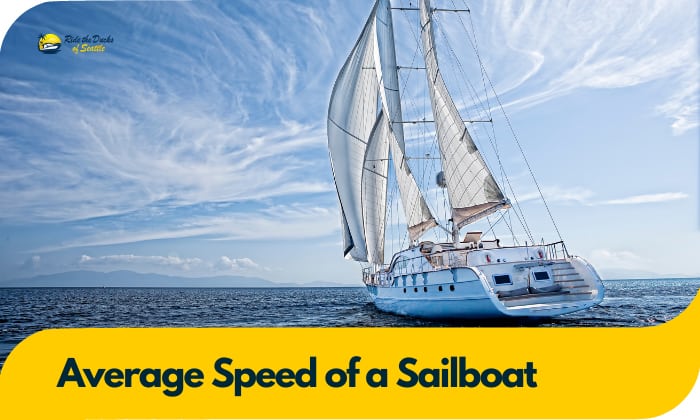
You might have seen how sailing yachts seem to outpace motorized boats in a regatta, prompting you to ask about the average speed of a sailboat. Although the record holder (the Vestas Sailrocket 2) can blitz to 65.5 knots, the run-off-the-mill sailing vessel can only reach four to six knots.
Several factors influence sailboat speeds, and we will examine each in this article. Please keep reading, so you will not miss the invaluable information you will get from this post.
Table of Contents
1. Hull shape
2. sailboat length, 1. alternative measurement, 2. converting knots to kph or mph, 1. hull type, tips to improve speed, frequently asked questions, how fast can a sailing vessel go.
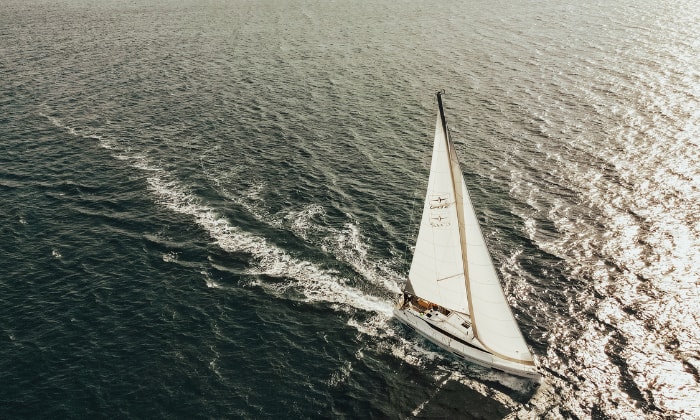
Regatta-competing racing sailboats can reach a top speed of about 20 knots, while custom-built high speed racing yachts can log 50 knots. As mentioned, the Vestas Sailrocket 2 blitzes the waters at a dizzying 65.5 knots (75.38 miles per hour or 121.31 kilometers per hour).
On the other hand, the average sailboat in lakes and other bodies of water can only top the speed charts at seven knots (8.06 MPH or 12.97 KPH), averaging about four to six knots (4.6 to 6.9 MPH or 7.4 to 11.1 KPH).
An 1800s or 1970s sailing ship (i.e., galleon or clipper) has about the same speed as the average modern sailboat. However, it is worth noting that the Sovereign of the Seas logged the highest velocity for a sail-powered ship at 22 knots (25.32 MPH or 40.75 KPH) in 1854.
Meanwhile, the fastest sailing dinghy is the International Moth, blasting the waters at 35.9 knots (41.3 MPH or 66.5 KPH).
So, why the variance?
Two intrinsic (within the boat itself) factors impact the speed of sailboat units. These include hull shape and vessel length.
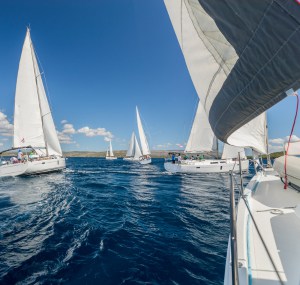
Racing sailboats are faster than cruising yachts because of their unique hull shape differences.
A sailboat built for speed has a super-slim hull and straight buttock lines. The aft section forms a straight line between the slightly wide transom and the hull’s lowest point.
Meanwhile, sluggish sailboats have a “fat tub” hull shape, a narrow stern, and a curvy hull.
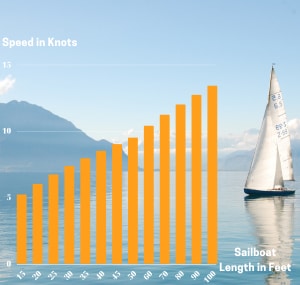
There is a scientific explanation about the impact of sailboat size (or length) on its speed. Sailing vessels create a wave pattern as they move along the water, one at the front and another at the back.
A water wave sufficient to help the boat move occurs if the sailboat’s length is similar to the length of the wave. This phenomenon “lifts” the vessel’s bow, increasing its speed while reducing water resistance.
Hence, a longer sailboat will have a greater cruising speed than short vessels because they can create longer waves.
We prepared the following table to illustrate how vessel length impacts sailboat speed. Hence, a 40 ft. sailboat will always be speedier than shorter sailing vessels (<40 feet).
| 15 | 5.19 |
| 20 | 5.99 |
| 25 | 6.7 |
| 30 | 7.34 |
| 35 | 7.93 |
| 40 | 8.48 |
| 45 | 8.99 |
| 50 | 9.48 |
| 60 | 10.38 |
| 70 | 11.21 |
| 80 | 11.98 |
| 90 | 12.71 |
| 100 | 13.4 |
How to Calculate the Speed
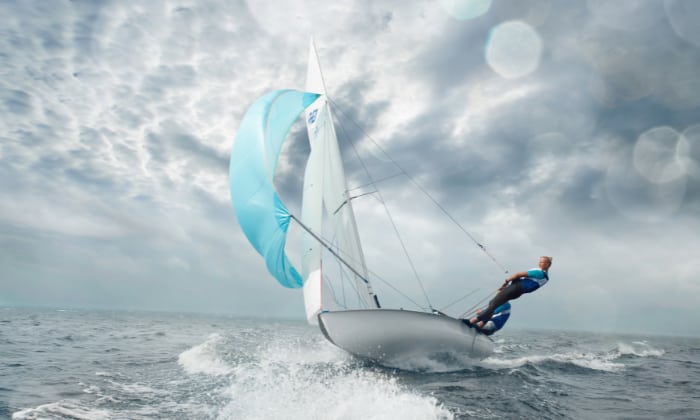
You can use an online sailboat speed calculator, input the required variables, and the system will automatically run the equation. Alternatively, you can determine your sailboat’s average speed by following this simple formula.
Average yacht speed knots = (√(LWL))x 1.34
In which “LWL” is your sailboat’s length at the waterline
Suppose you have a 36-foot sailboat that measures 26 feet at the waterline. The square root of 26 is 5.099. Multiplying this number by 1.34 will result in 6.832 or 6.8 knots.
How about a 59-foot sailing vessel with a waterline length of 47 feet? The square root of 47 is 6.86. We will get 9.19 knots after multiplying 6.86 by 1.34.
Please note that this sailboat speed is the average, provided you have clear skies, calm seas, and an ideal sailboat setup.
For example, suppose we achieved 6.8 knots with 15-knot winds and a sail setup of 50- to 120-degree true wind angle. We can expect our sailboat example to be slower if we do not achieve these conditions.
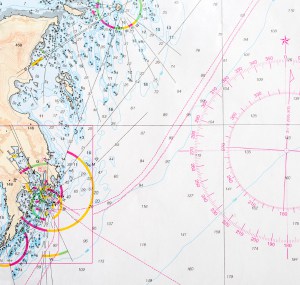
You can also determine your sailboat’s speed by sailing from one point to another. However, you might have to ascertain the distance between these two locations beforehand, and it should be in nautical miles (NM).
Why nautical miles? We are measuring sailboat speeds in knots. One knot is equivalent to one NM per hour. It is worth noting that one NM is 1.15 land-based miles, to put it in perspective.
Take the known distance between the two locations (in nautical miles) and divide the number by the time it took you to complete the journey.
For example, suppose you sailed from Buffalo, New York to Detroit, Michigan, with a distance of 186.99 nautical miles, and it took you 23 hours to complete the journey. In that case, 186.99 divided by 23 hours is 8.13 knots.
You can also take your average sailing distance per day to gain a more comprehensive understanding of your sailboat’s speed. For example, a sailboat with a 6-knot average speed can cover 144 nautical miles in 24 hours (6 x 24 = 144).
Something might be amiss if your boat sailed for 24 hours and covered less than 144 nautical miles. You might have more favorable sailing conditions if you traveled the distance in less than 24 hours.
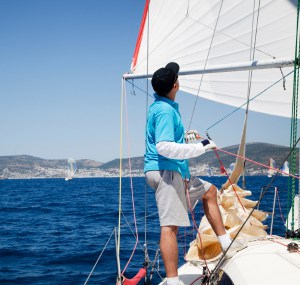
Sailors use “knots” as the unit of measure for vessel speed. Unfortunately, ordinary mortals are unfamiliar with this metric. They are more in tune with “miles per hour” (MPH) or “kilometers per hour” (km/h or KPH).
We mentioned that a nautical mile is slightly longer than a land-measured mile (1.15 statute miles). We also know that 1 NM per hour is 1 knot. Hence, we can multiply the “knot” value by 1.15 to determine your sailboat’s speed in MPH (miles per hour).
A mile is also longer than a kilometer (1 mile = 1.60934 kilometers). Thus, we can assume our KPH values will be higher than knots and MPH. We can multiply “knots” by 1.852 to get the value in KPH.
For example, a top speed sailboat blitzing at 50 knots has a maximum velocity of 57.5 MPH (50 knots x 1.15) or 92.6 KPH (50 knots x 1.852).
On the other hand, a 6.5-knot sailboat can only muster 7.475 MPH or 12.038 KPH.
Factors Affecting Sailboat Speed
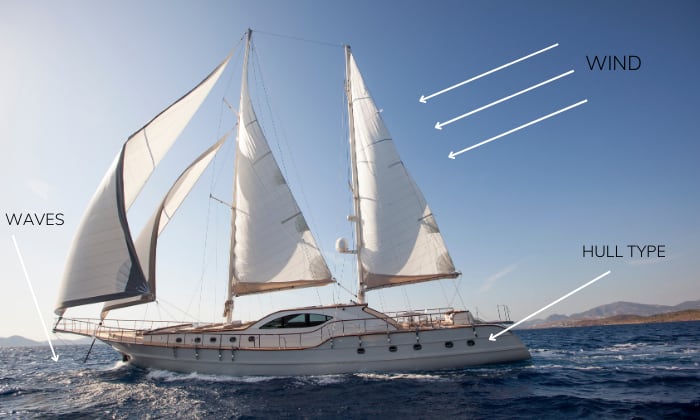
Although we already discussed hull shape and vessel length’s influence on sailboat speed, three other factors can impact watercraft velocity.
Sailboats with at least two hulls (catamarans) are 25 to 30 percent faster than monohulls, given equal lengths.
Hence, if a single-hulled sailboat can go six knots, we can expect a catamaran to have an average speed of 7.5 to 7.8 knots (8.625 to 8.97 MPH or 13.89 to 14.45 KPH). This sailboat hull can match a racing monohull sailboat’s velocity with better comfort.
Add another hull to the catamaran (a trimaran), and you can outpace a racing monohull by doubling its velocity.
Although some sailboats have engines, most rely on wind power for propulsion. Hence, stronger winds can make a sailboat go faster by pushing against the sail. Unfortunately, wind direction can also influence vessel speed. You can go fast if the wind blows in your heading.
You might be inclined to believe that calm waters can make your sailboat go faster. Unfortunately, serene waters often mean gentle winds. And if there is not much wind to push the sail, you cannot expect your vessel to go faster.
Current, wind, and wave or sea condition is the most important factor in determining a safe vessel speed. If the water is rough, it is safer to reduce speed because bad weather can impair visibility and make it challenging to maneuver the vessel.
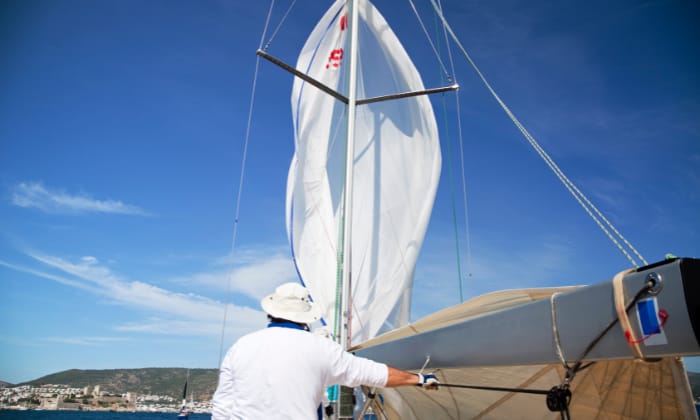
Here are some tips to improve sailboat speed.
- Ensure the sailboat’s proper operating condition, especially the mast, sail, and extrusions. Check the hull and foils.
- Be mindful of the sailboat’s maximum weight capacity, ensuring you do not exceed the rating. Moreover, the correct weight distribution can help you pilot the sailboat faster.
- You might want to brush up on your sailing competencies, including sail control, steering, sail angling, genoa and jib control, kite curling, efficient pumping, and wind positioning.
- Check your sailboat’s settings, including the shroud tension, mast rake, jib car position, mast step position, keel position, and vang tension.
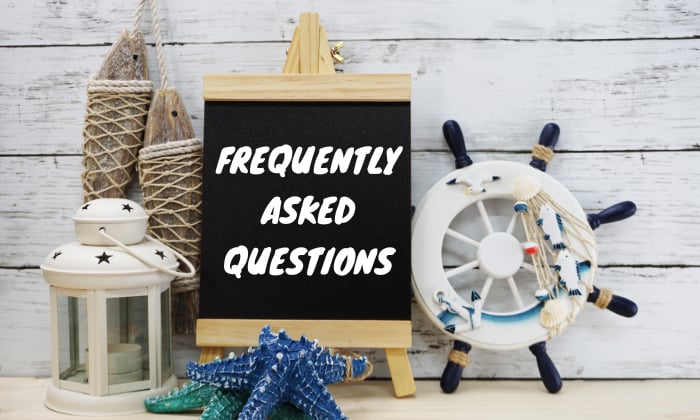
Sailboat speed vs wind speed: which’s faster?
A vessel sailing faster than the wind is possible with a superiorly designed and streamlined hull and the correct sail angle. Otherwise, the sailboat will only be as fast as the wind speed on the sail.
It is also worth mentioning that sailboats with multiple hulls or a planing hull can be faster than wind speeds.
How fast can a sailboat go under power?
A sailboat under power can move on the water at an average velocity of four to five knots (nautical miles per hour) or 5 MPH (8 KPH). This is not very fast but not slow either.
Are catamarans or monohulls faster?
Multihulls (i.e., catamarans and trimarans) are faster than monohulls, averaging about nine to ten knots (10.35 to 11.5 MPH or 16.69 to 18.52 KPH). On the other hand, monohulls only average six to eight knots (6.9 to 9.2 MPH or 11.11 to 14.82 KPH).
The average speed of a sailboat varies across sailing vessel types, sailboat lengths, hull shapes, and hull types. Wind and waves can also influence sailboat velocity.
Given ideal weather conditions, the average sailing vessel can cruise at four to six knots. Custom-built, high-performance racing yachts can blitz the waters at up to 65 knots. Twin-hulled sailboats are 25 to 30 percent faster than their single-hull counterparts, while triple-hulls are super-quick.
Of course, everything depends on wave and wind conditions.\
Read more : The fastest speed of a boat.

Ten years of enjoying countless trips on boats never made me love them any less! So I am here to put all those experiences into good use for other boaters who want to have a safe and fun trip with their friends and families.
Sailing Boat Speed Calculator
Mastering sailing means knowing your boat’s performance well. One key part is figuring out its speed. This guide will show you how to measure your sailing boat’s speed accurately. It’s useful for both experienced sailors and beginners.
You’ll learn how to check your boat’s speed, what affects it, and how to make your sailing better. This includes getting the most out of your sailing experience.
Key Takeaways
- Discover the fundamental formulas for calculating sailing boat speed
- Understand the key factors that affect a sailboat’s velocity, such as wind patterns and hull design
- Learn how to properly use essential tools for measuring and tracking your boat’s speed
- Explore the importance of knot conversion and nautical mile calculations in sailing
- Gain insights on analyzing hull hydrodynamics and sail trim adjustments for optimal speed
Understanding Sailboat Speed Dynamics
Knowing a sailboat’s speed is key to navigating the sea. Sailors once used log lines and watched wake patterns to guess their speed. Now, thanks to tech, measuring speed is more precise and easy.
Factors Affecting Boat Velocity
Many things affect a sailboat’s speed. The hull design, wind, and crew skill are all important. The keel shape, sail size, and angle, and how the boat is trimmed all matter .
Wind Patterns and their Influence
The wind’s direction and strength greatly impact a sailboat’s speed. Sailors must adjust their sails and course to match the wind . This helps them sail faster and safer.
Today, apps and digital tools help sailors measure speed accurately. These tools have changed sailing, making it more precise and enjoyable.
Measuring Sailboat Speed: Essential Tools
Knowing your sailboat’s speed is key to better sailing and safety. There are many tools to track your boat’s speed, from simple speedometers to advanced GPS devices.
A speedometer is a common way to see how fast is 50 knots in a boat? . These devices show your boat’s speed in real time. But, they might not always be right, especially when the wind and water change.
GPS trackers are a better choice for many sailors. They use satellites to find your location and speed. These trackers are very accurate and can save your sailing data for later.
- Speedometers: Provide a real-time readout of your boat’s speed, but may not be as accurate in variable conditions
- GPS Trackers: Offer precise speed measurements using satellite technology, and can log sailing data for later review
- Mobile Apps: Leverage your smartphone’s GPS to track your how fast can a 40 hp boat go? and other sailing metrics
- Advanced Instrumentation: Sophisticated systems with multiple sensors, providing comprehensive performance data
For more detailed speed tracking, advanced systems are available. These include anemometers for wind speed and depth finders for water depth. They give a full picture of your boat’s performance.
| Tool | Accuracy | Features | Limitations |
|---|---|---|---|
| Speedometer | Moderate | Real-time speed display | May not be accurate in variable conditions |
| GPS Tracker | High | Precise speed measurement, data logging | Requires satellite connection |
| Mobile App | Moderate to High | Leverage smartphone GPS, data tracking | Depends on mobile device and signal strength |
| Advanced Instrumentation | High | Comprehensive performance data, multiple sensors | Typically more expensive and complex to install |
Knowing what each tool can do helps you pick the right one for your sailing. This way, you can enjoy your time on the water to the fullest.
sailing boat speed calculation
Knowing how to calculate a sailing boat’s speed is key for safe and efficient sailing. The formula helps sailors predict their boat’s speed, plan routes, and make smart decisions on the water.
Factors Influencing Sailboat Speed
Several factors affect a sailing boat’s speed. These include wind, boat design, and the crew’s skill. The formula for sailboat speed considers these, giving a good estimate of the boat’s speed.
The basic formula is: Boat Speed = 1.34 x √(Waterline Length) . This formula looks at the boat’s waterline length, which is the hull part underwater when the boat is still.
But remember, this formula is just a starting point. Actual speeds can change due to wind speed , sail trim , and crew skill . Experienced sailors can often go faster, especially with good wind.
Can One Person Sail a 35-Foot Sailboat?
Yes, one person can sail a 35-foot sailboat, but it’s tough and requires a lot of effort, especially in strong winds. The boat’s design, the sailor’s experience, and the weather all matter in this challenge.
It’s usually safer and easier to have at least two people on a 35-foot sailboat. This way, tasks like sail handling and navigation can be shared, making sailing less stressful for everyone.
| Boat Length | Recommended Crew Size | Estimated Maximum Speed (Formula) |
|---|---|---|
| 25 feet | 1-2 people | 6.7 knots |
| 35 feet | 2-3 people | 7.9 knots |
| 45 feet | 3-4 people | 8.9 knots |
Knot Conversion and Nautical Mile Calculations
Knowing how to convert knots and calculate nautical miles is key for sailors. These tools help you understand your speed, whether you’re on a big boat or just out for fun. It’s all about getting the right numbers for your sailing journey.
The knot is a speed unit used at sea, meaning one nautical mile per hour. To change knots to miles per hour (mph) or kilometers per hour (km/h), use these formulas:
- Knots to mph: Multiply knots by 1.15
- Knots to km/h: Multiply knots by 1.85
To figure out how far you’ve gone in nautical miles, you need your speed in knots and how long you’ve been sailing. Here’s how:
- Multiply your speed (in knots) by the time (in hours)
- The answer is how far you’ve sailed in nautical miles
For instance, if your 40-foot boat is moving at 8 knots for 3 hours, you’ve sailed 24 nautical miles.
| Speed (Knots) | Speed (mph) | Speed (km/h) |
|---|---|---|
| 5 | 5.75 | 9.25 |
| 8 | 9.2 | 14.8 |
| 10 | 11.5 | 18.5 |
Learning these conversions and calculations helps sailors track their journey. It lets them plan better and sail at a comfortable speed that suits their boat and the weather.
Analyzing Hull Design for Optimal Speed
The design and hydrodynamics of your sailboat’s hull are key to its speed. Knowing how water resistance works can help you make your boat faster. You can tweak things like hull shape, weight, and waterline length to improve performance.
Hydrodynamics and Water Resistance
When a sailboat moves, it faces resistance that affects its speed. This resistance, or hydrodynamic drag, depends on the hull design. Things like hull shape, weight, and waterline length play a big role in how well the boat cuts through the water.
Surprisingly, a lighter sailboat may not always be faster . It’s not just about being light. How the boat’s weight is spread out and how it interacts with the water matters more. On the other hand, if a sailboat goes too fast , it can face more water resistance. This can make it less efficient and harder to handle.
- Optimize hull shape to reduce water resistance and improve speed
- Balance weight distribution to enhance stability and maneuverability
- Adjust waterline length to find the sweet spot for your boat’s performance
By tweaking these important factors, you can make your sailboat go faster. This will make your sailing experience more exciting and efficient.
Wind Speed and Sail Trim Adjustments
Sailing is not just about the size of your boat. It’s about using the wind to your advantage. Whether you have a 50 ft sailboat or a 30 foot sailboat , knowing how to adjust your sails is key. This knowledge can greatly improve your speed.
It’s important to watch the wind and adjust your sails as needed. By finding the right angle for your sails, you can make the most of the wind. This is what makes your sailboat go fast.
Adjusting Sails for Maximum Speed
- Flatten the sails in strong winds to reduce drag and heel
- Increase the sail’s angle of attack in lighter winds to generate more lift
- Adjust the position of the keel and rudder to maintain optimal balance and tracking
- Experiment with different sail configurations to find the sweet spot for your specific sailing conditions
The wind and your sail trim are always changing. By paying attention and making quick changes, you can make your how fast can a 50 ft sailboat go? or can a 30 foot sailboat cross the atlantic? better. Whether racing or just enjoying the ride, getting good at this will elevate your sailing experience.
| Sail Trim Adjustment | Wind Speed Range | Desired Effect |
|---|---|---|
| Flattening the sails | 15-25 knots | Reduce drag and heel |
| Increasing sail angle of attack | 5-15 knots | Generate more lift |
| Adjusting keel and rudder position | All wind conditions | Maintain optimal balance and tracking |
“The secret to sailing fast is not the size of the boat, but the skill of the crew in adjusting the sails to the ever-changing wind conditions.”
Estimating Cruising Speeds for Different Boat Sizes
The size of your boat greatly affects its cruising speed. Whether you’re sailing a 27-foot sailboat or a 40-foot yacht, knowing the typical speeds helps. It lets you plan your sailing trips better.
Guidelines for Various Sailboat Lengths
Smaller sailboats, like 27-foot ones, cruise at 5 to 7 knots (5.8 to 8 mph). They can go faster, but cruise slower. Larger 40-foot sailboats cruise at 7 to 9 knots (8 to 10 mph), offering more speed and stability.
Remember, these speeds are just estimates. Can a 30 foot sailboat capsize? Many things affect a sailboat’s speed, like design, weight, and weather. How fast did old ships sail mph? Skilled sailors adjust their sails for better speed and efficiency.
“The faster you sail, the sooner you’ll get there – and the sooner you’ll be back home again.”
It’s key to prioritize safety, no matter the boat size. Knowing typical speeds helps plan safe and enjoyable voyages.
Safe Speed Limits and Capsize Prevention
Keeping a safe speed is key when sailing. Going too fast can lead to dangerous situations, like capsizing. Wind, boat design, and water conditions all affect a sailboat’s speed. It’s important to know these factors for a safe and fun experience.
A nautical mile is about 6,076 feet, longer than a regular mile’s 5,280 feet. This difference matters when you’re calculating speeds and distances. Also, a knot is 1 nautical mile per hour, or about 47 feet per second.
To avoid capsizing, sailors need to watch their speed closely. They might need to adjust their sails, trim, or slow down. By understanding these steps and monitoring the boat’s performance, sailors can stay safe and avoid the dangers of too much speed.
How do you calculate the speed of a sailboat?
To find a sailboat’s speed, use this formula: Boat Speed = (Wind Speed x Sail Efficiency) – Leeway. It considers wind, sail efficiency, and leeway.
What is the formula for calculating the speed of a boat?
The formula is simple: Speed = Distance / Time. It works for both power and sailboats. But, wind, hull design, and sail trim affect speed differently.
How do you measure boat cruising speed?
You can use a speedometer, GPS, or mobile apps. Speedometers and GPS give real-time speeds. Apps calculate speed over time using GPS.
How fast can a 27 foot sailboat go?
A 27 foot sailboat’s top speed depends on wind, hull design, and sail trim. But, it usually goes 6-10 knots (7-11 mph) with good conditions.
How fast can a 40 foot sailboat go?
A 40 foot sailboat can hit 8-12 knots (9-14 mph) in moderate winds. With perfect conditions, it might reach 15 knots (17 mph) or more.
How fast is a 30 foot sailboat?
A 30 foot sailboat cruises at 6-8 knots (7-9 mph) in moderate winds. Ideal conditions can push it to 10-12 knots (11-14 mph).
How did sailors calculate their speed?
Sailors used a “chip log” to estimate speed. It’s a weighted piece of wood on a line. Counting knots in the line gave them speed in nautical miles per hour.
How do you measure boat speed?
Use a speedometer, GPS, or mobile apps. Speedometers and GPS show real-time speeds. Apps calculate speed over time with GPS.
What is the correct formula for calculating speed?
The formula is: Speed = Distance / Time. It works for all vehicles, including boats, to find their speed.
Is there an app to measure boat speed?
Yes, apps like Navionics, iNavX, and Boat Tunes use GPS to measure speed. They also offer other sailing data.
How fast is 50 knots in a boat?
50 knots is about 57.5 mph or 92.6 km/h. It’s very fast for small boats and can be dangerous.
How fast can a 40 hp boat go?
A 40 hp boat’s top speed varies by hull design, weight, and more. But, it usually goes 25-35 mph (21-30 knots).
Related posts:
- High Sail Boat Speed in Knots Calculator
- Pontoon Boat Speed Calculator
- Rowing Boat Speed Calculator
- Boat Fuel Tank Size Calculator
- Boat Shipping Cost Calculator
- Boat Weight Calculator
- Boat Towing Weight Calculator
- Boat Depreciation Calculator
- Boat Fuel Consumption Calculator
- Ball Speed to Swing Speed Calculator
- Pace to Speed and Speed to Pace Calculator
- Hand Speed to Club Head Speed Calculator
- Angular Speed to Linear Speed Converter
Leave a Comment Cancel reply
Save my name, email, and website in this browser for the next time I comment.
- Navigating the waters of boat speed: From average speed to catamaran top speed
Boat speed is a fascinating aspect of maritime life, encompassing both art and science. It's a subject that captivates sailors, enthusiasts, and those new to the world of boating alike. In this comprehensive guide, we will unravel the secrets of boat speed, exploring terms like average speed, speed knots, cruising speed, and even the incredible 420 knots to mph conversion.
Average speed
Average speed is a fundamental metric for any boat journey. It represents the pace at which a vessel covers a specific distance over time. For most leisure boats, the average speed typically falls within the range of 20 to 30 knots. However, it's essential to note that different boat types have varying average speeds due to their size, design, and intended use.
Boat speed in knots
Boat speed is often expressed in knots, a unit of speed commonly used in maritime contexts. One knot is equivalent to one nautical mile per hour. Knots provide a precise measurement of a vessel's velocity relative to the water. Understanding the concept of knots is crucial for any sailor or boat enthusiast.
Cruising speed
Cruising speed is the comfortable pace at which most recreational boaters prefer to travel. It balances efficiency and comfort, allowing passengers to enjoy a leisurely journey while minimizing fuel consumption. Achieving the ideal cruising speed requires a keen understanding of the boat's capabilities and the conditions of the voyage.
How fast is a knot?
The question of "how fast is a knot?" often arises among those new to boating. As mentioned earlier, one knot is equivalent to one nautical mile per hour, which is approximately 1.151 miles per hour (or 1.852 kilometers per hour). This simple conversion helps sailors interpret speed measurements accurately.
420 knots to MPH
Reaching speeds of 420 knots is an incredible feat in the world of boating. To put this in perspective, it's approximately equivalent to 483 miles per hour. Such high speeds are typically achieved by specialized vessels designed for speed sailing or racing. These boats are equipped with advanced technology and skilled crews to navigate at supersonic speeds.
Read our top notch articles on topics such as sailing, sailing tips and destinations in our Magazine .
Sailboats at sea.
Check out our latest sailing content:
Speed sailing.
Speed sailing is an exhilarating sport that pushes the limits of boat speed. Participants in speed sailing competitions strive to reach and maintain the highest possible speeds in specially designed boats. These events showcase the fusion of cutting-edge technology and the skill of the sailors as they harness the power of wind and water to achieve remarkable velocities.
Catamaran to speed
Catamarans are renowned for their impressive top speeds. These twin-hulled vessels offer stability and speed, making them a favorite among enthusiasts. While top speeds vary depending on the specific catamaran's design and size, it's not uncommon for catamarans to reach speeds of 20 knots or more, providing an exhilarating and smooth sailing experience.
In conclusion, boat speed is a multifaceted topic that encompasses various measurements, from average speed to the incredible 420 knots to mph conversion. Understanding these aspects of boat speed allows sailors and boating enthusiasts to navigate more effectively and make the most of their maritime adventures. Whether you're cruising leisurely or chasing the thrill of speed sailing, the world of boat speed has something to offer for everyone.
So what are you waiting for? Take a look at our range of charter boats and head to some of our favourite sailing destinations.
I am ready to help you with booking a boat for your dream vacation. Contact me.

Denisa Kliner Nguyenová
No products in the cart.
Sailing Ellidah is supported by our readers. Buying through our links may earn us an affiliate commission at no extra cost to you.
How Far You Can Sail In A Day: Calculating Speed And Distance
A sailboat can travel 144 nautical miles in 24 hours with an average cruising speed of 6 knots, which is realistic for a 35-45-foot sailboat. If the average speed is reduced to 5 knots, you will cover 120 nautical miles in the same timeframe.
In this article, you’ll discover how many nautical miles you can sail at any time based on your average boat speed. You’ll also learn how to calculate boat speed and examine factors affecting your sailing journey.
UPDATE: I have included a Sailing Distance Calculator and a Hull Speed Calculator for your convenience .
How to calculate the average distance in relation to speed and time
If you are familiar with your boat and know your average cruising speed, it is easy to calculate how far you can sail at any time.
Multiply your average speed in knots with time in hours; the result will show the distance covered in nautical miles. Remember that when calculating your distance, you want to use your speed toward your destination, not your speed over the ground, especially when you are sailing angles.
This term is VMC or VMG-C: Velocity Made Good on the Course.
VMG indicates the speed of your vessel directly towards or away from the wind . VMC indicates the speed of your vessel directly toward your destination .
Your average speed toward your destination “VMC ” and speed over ground “SOG ” will only be the same when you sail directly toward your target. Most modern sailing instruments and chart plotters can show your VMC if you have plotted a route to your destination and calculate your estimated time of arrival, or ETA, based on this number.
How far you can sail in a day, half a day, and 8 hours
I made a table that shows you how far you can sail in 8, 12, and 24 hours based on average cruising speed:
| | | | “ |
| 2 | 16 | 24 | 48 |
| 2.5 | 20 | 30 | 60 |
| 3 | 24 | 36 | 72 |
| 3.5 | 28 | 42 | 84 |
| 4 | 32 | 48 | 96 |
| 4.5 | 36 | 54 | 108 |
| 5 kt | 40 | 60 | 120 |
| 5.5 | 44 | 66 | 132 |
| 6 | 48 | 72 | 144 |
| 6.5 | 52 | 78 | 156 |
| 7 | 56 | 84 | 168 |
| 7.5 | 60 | 90 | 180 |
| 8 | 64 | 96 | 192 |
Sailing Distance Calculator
Distance (NM) = Speed (Kt) x Time (Hrs)
Useful Terms
VMG – Velocity Made Good VMC – Velocity Made Good on the Course SOG – Speed Over Ground SOW – Speed Over Water LOA – Length Overall LWL – Loaded Waterline Length NM – Nautical Mile Kt – Knots Clicking this box will take you to The Sailors Guide To Nautical Terms.
How to determine your average sailing speed
If you are new to sailing and unfamiliar with your sailboat, you first want to determine what speed you can expect to sail. The best way to determine your average cruising speed is by getting to know your boat and how it performs in different weather conditions at different points of sail.
Factors Affecting Sailing Speed
While calculating the average sailing distance of a boat, it’s crucial to understand that sailing speed depends on various factors. For example, your speed will be affected when you are beating into the wind or a current.
And you don’t always want to push your boat to its limit to reach your top speed. In many situations, you may want to bear off your course to reduce the stress on the vessel, crew, and yourself. Doing so will reduce your average speed towards your destination.
There are several things that will affect your speed at sea, and I’ve listed the major ones here:
- Hull length: The longer the boat, the higher the potential maximum hull speed is because of the increased water length. Larger boats typically carry larger sails, which also increase their speed potential.
- Sail area: The sail surface area affects the boat’s speed. Larger sail areas catch more wind, resulting in higher speeds. However, larger sails can also make it more challenging to manage the boat, especially in strong winds. The sails rely on their shape to drive the vessel forward, and the shape of a sail will change as they get older, making them less effective. Learn more about types of sails here .
- Tide and currents: Sailing with the tide and using currents to your advantage will positively impact your sailing speed. Sailing into it, or beating as we call it in the sailing world, will reduce your speed.
- Weather conditions: The wind’s strength and direction are critical in determining your boat’s speed. Light winds may slow your progress, while strong winds can make for faster sailing or lead to challenging conditions that require you to reduce speed for safety. You also have to consider your point of sail and the wind speed affecting you .
- Crew experience: A skilled crew can efficiently trim sails and navigate, maximizing the boat’s performance, which translates to more nautical miles covered per day. Some vessels are even easy to sail effectively solo if the skipper knows what he is doing. However, most cruisers would rather be chasing a comfortable ride than the vessel’s maximum potential.
- Boat condition: A well-maintained boat with a clean hull, good sails, and solid rigging will perform much better and ultimately cover more distance than a neglected vessel. You’ll also have more confidence in a well-kept boat when you get to the point where you are pushing yourself and your vessel toward your limits.
When you know your boat and its behavior in the water, you can estimate the average speed by doing simple calculations.
How fast do sailboats go? Maximum hull speed explained
Most cruising sailboats (except for catamarans, trimarans, and some light racing boats) are usually displacement boats. This basically means that the boat is sailing through the water instead of surfing on top of it.
A displacement sailboat’s hull speed is the speed your boat has achieved when its created wave has the same length as the vessel’s loaded waterline length (LWL).
Many boats can exceed their hull speed, but the formula below will give us a decent number as a reference to determine a realistic cruising speed. I made a calculator to make it easier for you.
Hull Speed Calculator
Hull Speed = 1.34 * √Load Waterline Length (LWL “ft”)
LWL “ft”:
Hull Speed:
We will use my sailboat “Ellidah’s” numbers in this example. She is 41 feet overall, but the loaded waterline length (the part of the hull that touches the water) is 32,75 feet. The square root of 32,75 is 5.722. We then multiply this result with a factor of 1.34 and get approximately 7.67.
Now that we found the boat’s hull speed at just above 7.6 knots, we know she should be able to reach this speed in pleasant sailing conditions.
Note: If you don’t know your boat’s LWL, look up your specs here.
Average sailboat speed
When I plan a passage, I calculate with an average speed of around 6 knots, which is about 20% below hull speed, and I have found it to be pretty accurate.
To continue using Ellidah as a reference, she does 7.5 knots on calm seas and 15 knots of wind, sailing between 120 and 50 degrees true wind angle. The speed will reach 5.5 – 6.5 knots at lower or higher angles.
A good rule of thumb for most is that we can usually sail at half the apparent wind speed until we reach the boat’s hull speed, as long as we don’t have any strong currents or big waves working against us.
The bottom line of these examples is to consider the boat’s setup and the conditions we will be sailing in. Given decent conditions with good sails, we should be able to sail close to the boat’s hull speed in ideal conditions.
Determining abilities and comfort level
The last important factor to consider is yourself. Most experienced sailors don’t chase the highest possible speed but rather one that makes the boat balanced and comfortable in the conditions. It might, for example, be a good idea to slow down when beating into waves to prevent any equipment from breaking.
When sailing at night in reduced visibility, it is wise to sail more conservatively and reduce the sails, especially if you are sailing solo.
The bottom line is that looking at numbers online will only give you some of the tools you need to determine your speed and how far you can expect to travel with your boat in any timeframe.
To truly master the planning, you need to get out there, get your sails up, and combine your knowledge with the theory. After a while, you will be able to impress your friends with accurate estimations of speed, time, and distance.
A realistic average speed for sailboats between 30 and 50 feet
If you don’t want to bother with the calculations just yet and get out on the water as soon as possible, I made a little cheat sheet to help. I calculated the hull speed of small and big sailboats ranging from 30-50 feet and put them into a table.
Since we need to consider the factors discussed in this article, I have also subtracted 20% off the hull speed and rounded the result to give a more accurate estimate of a realistic cruising speed.
| Sailboat Name | Sailboat LWL in feet “ft” | Hull Speed in knots “kt” | Average Cruising Speed in knots “kt” |
|---|---|---|---|
| Contest 30 | 24.92 ft | 6.7 kt | |
| Beneteau First 35 | 28.83 ft | 7.2 kt | |
| Oyster 42 | 33.75 ft | 7.8 kt | |
| Amel Maramu 46 | 35.75 ft | 8.0 kt | |
| Hallberg Rassy 49 | 41.00 ft | 8.6 kt |
Final words
How far you can sail in a given time depends on your sailboat’s speed. How fast you can go depends on the weather conditions, the type and size of the boat, your setup, your equipment, and your capabilities and comfort.
Don’t get too obsessed with reaching your maximum speed unless you are racing. The trip might take a few extra hours when you slow things down, but you will enjoy yourself and your sailboat best when you are in control and sail conservatively, which comes with the benefit of being safer for both you and your boat.
Discover How Far You Can Sail In a Day – FAQ
How long does it take to sail 60 nautical miles.
With an average speed of 5 knots, you can expect to sail 60 nautical miles in about 12 hours. If you can increase your speed to 6 knots, it will take you 10 hours.
How long does it take to sail 100 miles?
With an average speed of 5 knots, it will take about 20 hours to sail 100 nautical miles. If you increase the speed to 6 knots, 100 nautical miles will take around 17 hours.
How fast do sailboats go?
- A sailboat between 30 and 40 feet will typically sail between 4 and 7 knots.
- A sailboat between 40 and 50 feet will typically sail between 5 and 8 knots.
How fast can a sailboat go under power?
Most modern sailboats have an engine dimensioned to power the boat up to its hull speed and basically make you able to achieve the same speed under power as under sail. There are, of course, exceptions. I wrote an article about sailing without sails that may interest you .
How do I convert speed in knots to miles per hour?
One knot equals one nautical mile per hour, which is 1.151 miles per hour. mph = knots * 1.151
What is the average speed of a 40 ft. sailboat?
The average speed of a 40 ft. sailboat is realistically about 6.5 knots in favorable conditions, depending on the type of boat, its sails, and its weight.
How far can a sailboat travel in a day?
What factors affect how far you can sail in a day.
The factors that affect how far you can sail in a day include the sailboat’s hull length, sailing speed, weather conditions, tide, and the sailing ability of yourself and the boat.
How does hull length affect the sailing distance of a boat?
Hull length plays a significant role in determining how far a sailboat can sail. Smaller sailboats with shorter hull lengths generally have lower maximum hull speeds. Larger boats with longer hull lengths can sustain higher speeds and cover many more nautical miles daily.
Can you sail downwind to cover more distance in a day?
Not necessarily. Some sailboats perform best with the wind behind the beam (downwind), such as catamarans and light semi-planing hulls. However, most displacement sailboats perform best close to a beam reach, with the wind in from the side. Besides, since you can’t change the direction of the wind, you’ll have to calculate your ideal velocity made good on the course toward your destination (VMC), depending on the conditions you are sailing in.
How fast can a sailboat typically sail?
The sailing speed of a boat depends on several factors, such as wind conditions and the boat’s design and size. A smaller vessel of around 30 feet will typically cruise at 5 knots +, depending on design. A 49-foot sailboat may cruise as high as 7 knots or higher on average, depending on its traits.
How can I determine the approximate maximum sailing distance of my boat?
To determine your boat’s approximate maximum sailing distance, you take your sailboat’s hull speed and multiply it with the time you intend to sail in hours. The result will give you your approximate maximum sailing distance for your boat in nautical miles.
How long does it take to sail a certain distance?
The time it takes to sail a certain distance depends on various factors, such as wind conditions and the sailing speed of the boat. By calculating the sailing speed and dividing the desired distance by it, you can estimate the sailing time required.
Can I sail for 8 hours in a day?
Yes, of course you can! With an average speed of 6.5 knots, you can travel 52 nautical miles in 8 hours.
Sharing is caring!
Skipper, Electrician and ROV Pilot
Robin is the founder and owner of Sailing Ellidah and has been living on his sailboat since 2019. He is currently on a journey to sail around the world and is passionate about writing his story and helpful content to inspire others who share his interest in sailing.
Leave a Reply Cancel reply
Your email address will not be published. Required fields are marked *
Yachting Monthly
- Digital edition

Busting the hull speed myth
- julianwolfram
- December 13, 2021
Waterline length is not the defining factor in maximum boat speed that we all think it is. Julian Wolfram busts the hull speed myth

Modern hull forms, like this Jeanneau SO440, use chines to create volume forward while keeping a narrow entrance at the waterline
Every sailor is delighted when the breeze picks up and the boat really starts to get going with a bone in her teeth.

Julian Wolfram is a physicist, naval architect, former professor of ocean engineering at Heriot-Watt in Edinburgh and a Yachtmaster Offshore who has cruised and raced for 45 years
The crew will want to know how fast she will go and perhaps surreptitiously race her against any similar sized boat in the vicinity.
Speculation may start about what allows one boat to go faster than another – is it the hull shape or the sails?
It is easy to spot good, well-trimmed sails but what about the hull ?
The important part is not visible below the water surface. However there is one key indicator that is often very apparent – the waves generated by the sailing yacht.
When a yacht picks up speed the wave pattern around it grows and the greater the speed the bigger the waves .
The energy in these waves is proportional to the square of their height – double the height and the energy goes up by a factor of four.
This energy comes from the wind , via the sails and rig , making the hull push water out of the way.
If less of this wind energy was wasted in producing waves the yacht would go faster.
When a typical displacement monohull reaches a speed-to-length ratio of around 1.1 to 1.2 (speed in knots divided by the square root of the waterline in feet) up to half the wind energy driving it is usually wasted in generating waves.
The hull speed myth: Half angle of entrance
So how can we tell if a yacht will sail efficiently, or have high wave resistance and waste a lot of energy generating waves?
The answer starts back in the 19th century with the Australian J H Michell.
In 1898 he wrote one of the most important papers in the history of naval architecture in which he developed a formula for calculating wave resistance of ships.

Light displacement cruising boat: The bow of this Feeling 44 is finer than older cruising boats
This showed that wave resistance depended critically on the angle of the waterlines to the centreline of the ship – the half angle of entrance.
The smaller the angle the smaller the height of the waves generated and the lower the wave-making drag.
A knife blade can slice through water with minimal disturbance – drag the knife’s handle through and you generate waves.
The big hull speed myth
For a displacement hull the so-called ‘hull speed’ occurs when the waves it generates are the same length as the hull.
This occurs when the speed-length ratio is 1.34.
It is claimed that hulls cannot go significantly faster than this without planing. It is called ‘the displacement trap’ but is a myth.

Heavy displacement cruising boat: An older design has a bow that is several degrees wider
As an example, consider a 25ft (7.6m) boat that goes at 10 knots in flat water.
This is a speed-length ratio of two. That is the average speed over 2,000m for a single sculls rower in a world record time.
The reason for this high speed is a half angle of entrance of less than 5º. Hobie Cats, Darts and many other catamarans have similarly low angles of entrance and reach even higher speed-length ratios with their V-shaped displacement hulls.
These hulls also have almost equally fine sterns, which is also critically important to their low wave resistance.
The monohull problem
Now a monohull sailing yacht needs reasonable beam to achieve stability and, unless waterline length is particularly long, the half angle of entrance will inevitably be much larger than those on rowing skulls and multihulls .
In his 1966 Sailing Yacht Design Douglas Phillips-Birt suggests values of 15º to 30º for cruising yachts.
Many older cruising yachts with long overhangs and short waterline lengths, for their overall length, have values around the top of this range.

Busting the hull speed myth: A Thames barge is a similar length and beam to a J-Class, but its bluff bow, built for volume, makes it much slower. Credit: Alamy Stock Photo
Newer sailing yachts, with plumb bows, have somewhat smaller half angles and a modern 12m-long fast cruiser may have a value around 20º and a racing yacht 17º or 18º.
Size matters here as, to achieve stability, a little yacht is likely to have a bigger half angle than a large one, such as the German Frers-designed 42m (138ft), Rebecca which has a half angle of entrance of under 13º.
Rebecca also has a fine, elegant stern which helps minimise the stern wave – I’ll come back to sterns and stern waves.
Interestingly the half angle of entrance is not mentioned in the otherwise excellent 2014 Principles of Yacht Design by Larsson et al, although it is currently used as one of the parameters in the preliminary estimation of wave resistance for ships.
While it is still particularly applicable to very slender hulls, naval architects are not generally familiar with Michell’s work.
His formula for wave resistance involves quadruple integrals of complex functions.

German-Frers’ designed Rebecca has a half angle of entrance of just 18°. Credit: Cory Silken
These are not ‘meat and drink’ for your average naval architect, and only a few mathematically inclined academics have much interest in theoretical wave resistance.
Michell’s work is rarely, if ever, covered in naval architecture courses now.
Nowadays the emphasis is much more on numerical methods, high-speed computers and computational fluid mechanics (CFD) using the so called Navier-Stokes equations.
Examining these equations, which apply to any fluid situation, does not give any insights into wave resistance, albeit they can model wave resistance very well when used in the piecewise manner of CFD.
It is very easy to measure the half angle of entrance at the design waterline when a yacht is out of the water.
Take a photograph directly upwards from the ground under the centreline at the bow.

Busting the hull speed myth: Multihulls achieve high speeds due to fine hulls, light displacement and ample stability. Credit: Joe McCarthy/Yachting Monthly
Now blow this up on a computer screen, or print it off at a large scale, and measure the angle with a protractor.
Alternatively, if you have a properly scaled accommodation plan drawn for a level close to the design waterline this will yield a reasonable approximation of the half angle of entrance.
Unfortunately there is not a simple relationship between the fineness of the bow and the wave drag.
But, all other things being equal, the smaller the half angle the better.
It is easy to measure and is a useful parameter to know when comparing yachts.

Stern shape and hull speed
The half angle of entrance cannot be taken alone as a measure of wave drag, and the fairness of the hull and in particular the run aft is also critical.
Just as the half angle of entrance dictates the height of the bow wave, so the fineness of the stern is a key influence on the height of the stern wave.
Consider the water flowing around both sides of the hull and meeting at the stern.

Modern race boats, like Pip Hare ‘s IMOCA 60, combine a fine angle of entrance with wide, flat hulls for maximum form stability and planing ability. Credit: Richard Langdon
If these streams meet at a large angle the water will pile up into a high stern wave.
On the other hand if they meet at a shallow angle there will be less piling up. A fine stern can maintain a streamline flow of water.
However if the sides of the hull meet at the stern at a large angle then the streamline flow will tend to separate from the hull, leaving a wide wake full of drag-inducing eddies.
Continues below…

How hull shape affects comfort at sea
Understanding how your hull shape responds to waves will keep you and your crew safe and comfortable in a blow,…

Boat handling: How to use your yacht’s hull shape to your advantage
Whether you have a long keel or twin keel rudders, there will be pros and cons when it comes to…

Sailing in waves: top tips to keep you safe at speed
Sailing in waves can make for a jarring, juddering experience and long, uncomfortable passages and at worst, a dangerous, boat-rolling…

How to cope with gusts and squalls
Spikes in wind strength can range from a blustery sail to survival conditions. Dag Pike explains how to predict which…
In many modern designs the hull sides are not far off parallel at the stern and it is then the upward slope of the buttock lines that are critical and, again, the shallower the slope the better from a hull drag perspective.
The slope of the buttocks can easily be measured if the lines plan is available and a good indication can be obtained from a profile drawing or a photo taken beam on with the boat out of the water.
Drawing a chalk line parallel to the centreline and half a metre out from it will provide a buttock line that can be checked visually for fairness when the boat is viewed from abeam.

A rowing scull easily exceeds its theoretical max hull speed. Credit: Alamy Stock Photo
Again, the smaller the angle the better – provided the transom is clear of the water.
An angle of more than 17º will lead to separated flow and eddy making. This also happens if the transom is immersed.
The greater the immersion the greater the drag, so weight in stern lockers on modern boats can be critical.
Modern hull design
The modern wedge shape attempts to resolve the conflicting demands of a small angle of entrance, good stability and a fine stern.
The plumb bow extends the waterline forward and, with the maximum beam taken well aft, the hull forward can be relatively narrow, providing a low half angle of entrance.
The stern is wide, which helps achieve good stability, but at the same time the buttocks rise slowly at a shallow angle to the water surface.
This gives a smooth and gradual change in the hull’s cross section area ensuring the water flow remains attached to the hull and that the stern wave is kept low.

A modern cruising boat gains stability from a wide stern, but needs twin rudders
This wide, flat stern also helps surfing down waves and possibly planing.
Some designs have chines just above the design waterline which increases usable internal volume and gives a little more form stability when heeled.
However, as soon as the chine is immersed there will be separation along the chine edge as water will not flow smoothly around a sharp edge.
It is just not possible to get the chine perfectly aligned with the streamlines of the water flow in all sailing conditions and there will be some extra drag at times.
There are two downsides to the wedge- shaped hull.

Overloading aft will create a large increase in drag
First the boat has to be sailed at a small angle of heel to keep the rudder properly immersed and to avoid broaching. This can be offset to some extent by using twin rudders .
The second is that the weight must be kept relatively low.
This is because a relatively small increase in weight causes a big increase in wetted surface area at the stern and hence in the frictional drag which makes the boat slower, particularly in light airs.
This is the downside of slowing rising buttocks and the reason why dinghy sailors get their weight forward in a light breeze .
Displacement Length Ratios
Traditionally for sailing yachts the displacement-length ratio has been used as a measure of speed potential, partly because it is easy to calculate from the yacht particulars.
It is waterline length (in metres) divided by the cube root of displacement (in cubic metres or tonnes).
A heavy boat, such as the Heard 35, will have a value of about 4 to 4.8.
A more moderate displacement boat, such as the Hallberg Rassy 342 or Dufour 32 Classic, will have a value in the range 5 to about 5.5; whilst a racing boat may a value of up to, and even over, 7.

A heavy displacement cruising boat with a fair run aft is less affected by additional weight
However the displacement length ratio can be misleading as making a hull 20% deeper and 20% narrower will keep the displacement the same but will significantly reduce the half angle of entrance and the wave drag.
It is interesting to note a Thames barge in racing trim has the same length-displacement ratio as a J class yacht, but their speed potential is vastly different.
Finally I should mention the older ‘length-displacement’ ratio, which is quoted in imperial units.
This is calculated by dividing a boat’s displacement in tons (2,240 pounds) by one one-hundredth of the waterline length (in feet) cubed.

Credit: Maxine Heath
It is still used in the USA and should be treated with caution.
The myth that your boat’s speed is only restricted by it waterline length does a disservice to its designers, and does little to help you understand how to get the best from her when the wind picks up.
Have a look at how the boat is loaded, how you sail on the wind, your boat handling and how much canvas you ask her to carry and you may discover more speed than you expect.
The remarkable John Henry Mitchell

Pioneer of wave theory
It’s worth saying a little more about the remarkable John Henry Michell.
He produced a series of ground-breaking papers including one that proved a wave would break when its height reached a seventh of its length.
He was the son of Devon miner who had emigrated to the gold mining area near Melbourne.
He showed such promise that he got a scholarship to Cambridge.
He was later elected a fellow of the Royal Society at the age of 35 – not bad for the son of a Devonshire miner.
His brother George was no slouch either – he invented and patented the thrust bearing that is named after him.
The half angle of entrance became the traditional factor for assessing the fineness of hulls.
It is defined as the angle the designed waterline makes with the centreline at the bow.It varies from less than 5º for very fine hull forms up to 60º or more for a full-form barge.
At higher speeds, modest increases in the half angle can give rise to substantial increases in wave resistance.
Enjoyed reading Busting the hull speed myth?
A subscription to Yachting Monthly magazine costs around 40% less than the cover price .
Print and digital editions are available through Magazines Direct – where you can also find the latest deals .
YM is packed with information to help you get the most from your time on the water.
- Take your seamanship to the next level with tips, advice and skills from our experts
- Impartial in-depth reviews of the latest yachts and equipment
- Cruising guides to help you reach those dream destinations
Follow us on Facebook , Twitter and Instagram.
- Types of Sailboats
- Parts of a Sailboat
- Cruising Boats
- Small Sailboats
- Design Basics
- Sailboats under 30'
- Sailboats 30'-35
- Sailboats 35'-40'
- Sailboats 40'-45'
- Sailboats 45'-50'
- Sailboats 50'-55'
- Sailboats over 55'
- Masts & Spars
- Knots, Bends & Hitches
- The 12v Energy Equation
- Electronics & Instrumentation
- Build Your Own Boat
- Buying a Used Boat
- Choosing Accessories
- Living on a Boat
- Cruising Offshore
- Sailing in the Caribbean
- Anchoring Skills
- Sailing Authors & Their Writings
- Mary's Journal
- Nautical Terms
- Cruising Sailboats for Sale
- List your Boat for Sale Here!
- Used Sailing Equipment for Sale
- Sell Your Unwanted Gear
- Sailing eBooks: Download them here!
- Your Sailboats
- Your Sailing Stories
- Your Fishing Stories
- Advertising
- What's New?
- Chartering a Sailboat
Hullspeed and the Speed/Length Ratio
So what gives one boat better hullspeed than another? This question was pondered long and hard by William Froude (1810 to 1869), a British engineer who had a special fascination with the sea and ships.
Funded by the Admiralty, who were clearly very keen to get some answers to this question, he built a tank testing facility at Torquay, where he experimented with various model hull forms.
As an early expert in model analysis he was well acquainted with the 'law of mechanical similitude' , which demonstrates among other things that there are few linear relationships in hull design.
So just what is the answer?
Let's take a look...
Hullspeed and the Matchbox Analogy
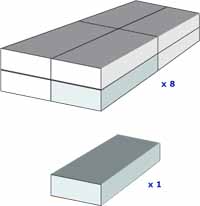
Consider your hull as a matchbox - not wonderfully efficient hydrodynamically, but stick with it for a moment.
Dissatisfied with the constraints of matchbox living, you decide to double its size. You add another matchbox ahead to double its length, two alongside to double its beam and four on top to double its draft.
Now wetted area has increased by four, volume and displacement by eight and stability - as the product of its mass and acceleration - has increased sixteenfold.
So by doubling a hull's dimensions, wetted area is squared, displacement is cubed and stability increases by the power of four.
With this knowledge and that gained by carefully measuring applied force and resultant movement, Froude was able to both calculate and demonstrate that a relationship existed between hull speed and waterline length - that relationship being known and described in the metric world as 'Froude Numbers'.
The Speed/Length Ratio
However, most of us more accustomed to units of feet and knots are probably more familiar with the Froude Number's close relation - the Speed/Length Ratio.
S/L Ratio = hullspeed (in knots) divided by the square root of the waterline length (in feet)
This discovery enabled Froude to compare the performance of boats of different length. For example a 25ft sailboat moving at 5 knots would have the same S/L Ratio at a 100ft patrol boat steaming along at 10knots, and consequently both would develop the same resistance per ton of displacement at those speeds.
For Froude's models, having no rig above the waterline to create windage, this resistance was caused by two principal factors; hull drag and wave making resistance.
Maximum Hull Speed
Maximum hull speed (in knots) = 1.34 x the square root of the waterline length (in feet)
|
20 feet 25 feet 30 feet 35 feet 40 feet 45 feet 50 feet |
6.0 knots 6.7 knots 7.3 knots 7.9 knots 8.5 knots 9.0 knots 9.5 knots |
These figures relate to a boat in displacement mode. If sufficient power can be applied to overcome hull drag and enable the boat to plane, then other criteria will affect ultimate hullspeed.
Any Questions?
What is the theoretical hull speed of a non-planing boat?
The theoretical hull speed is the maximum speed that a non-planing boat can achieve in displacement mode, when the wavelength of its bow wave is equal to its waterline length. Beyond this speed, the boat will encounter increasing wave resistance and will need more power to overcome it.
What factors affect the theoretical hull speed of a boat?
The main factor that affects the theoretical hull speed of a boat is its waterline length, which determines the wavelength of its bow wave. The longer the waterline length, the higher the theoretical hull speed. Other factors that may influence the actual speed of a boat include its hull shape, displacement, draft, trim, sail area, wind and sea conditions, and propeller efficiency.
What is the difference between planing and non-planing boats?
Planing boats are boats that can lift themselves partially or fully out of the water and ride on top of their own bow wave, reducing their wetted surface area and drag. Planing boats can exceed their theoretical hull speed and reach higher speeds with less power. Non-planing boats are boats that remain fully submerged in the water and cannot climb over their own bow wave. Non-planing boats are limited by their theoretical hull speed and require more power to increase their speed.
What is the 'half angle of entrance' and how does it affect wave resistance?
The half angle of entrance is the angle between the waterline and the centerline of a boat at its bow. The smaller the half angle of entrance, the finer the bow shape and the lower the wave resistance. A fine bow can slice through water with minimal disturbance, while a blunt bow can generate large waves and drag. The half angle of entrance is one of the key factors that determines the wave-making resistance of a boat.
How can I increase the speed of my non-planing boat?
There are several ways to increase the speed of your non-planing boat, such as:
- Increasing your sail area or using more efficient sails;
- Reducing your displacement or weight;
- Optimizing your trim or balance;
- Improving your propeller efficiency or reducing your propeller drag;
- Choosing a finer or longer hull shape;
- Sailing in favorable wind and sea conditions.
What are some common misconceptions about hull speed?
Some common misconceptions about hull speed are: - Hull speed is a fixed limit that cannot be exceeded by non-planing boats. In reality, hull speed is a theoretical estimate that can be surpassed by some boats with sufficient power or sail area, but at the cost of increased wave resistance and drag.
- Hull speed is the same for all boats with the same waterline length. In reality, hull speed can vary depending on the hull shape, displacement, draft, and trim of the boat, as well as the wind and sea conditions;
- Hull speed is the optimal speed for non-planing boats. In reality, hull speed is often too high for non-planing boats to maintain efficiently or comfortably, especially in adverse conditions. A lower speed that minimizes wave-making resistance and maximizes fuel or power efficiency may be more desirable.
The above answers were drafted by sailboat-cruising.com using GPT-4 (OpenAI’s large-scale language-generation model) as a research assistant to develop source material; to the best of our knowledge, we believe them to be accurate.
You might like to take a look at these...
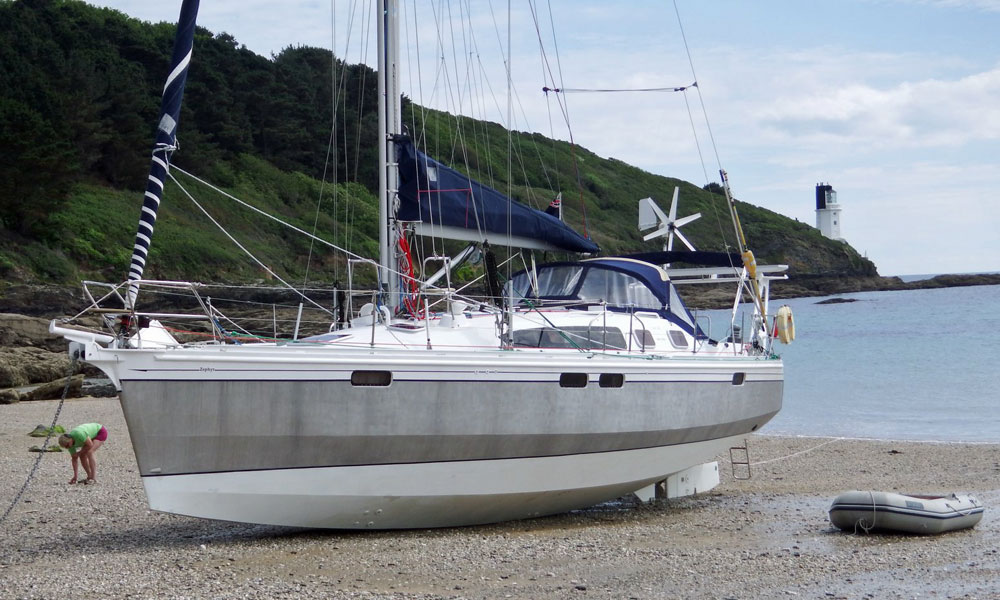
Why Some Sailboat Keels Perform Better To Windward Than Others
But it's not just about windward performance, other types of sailboat keels may suit your sailing area better and reduce your mooring costs; for example
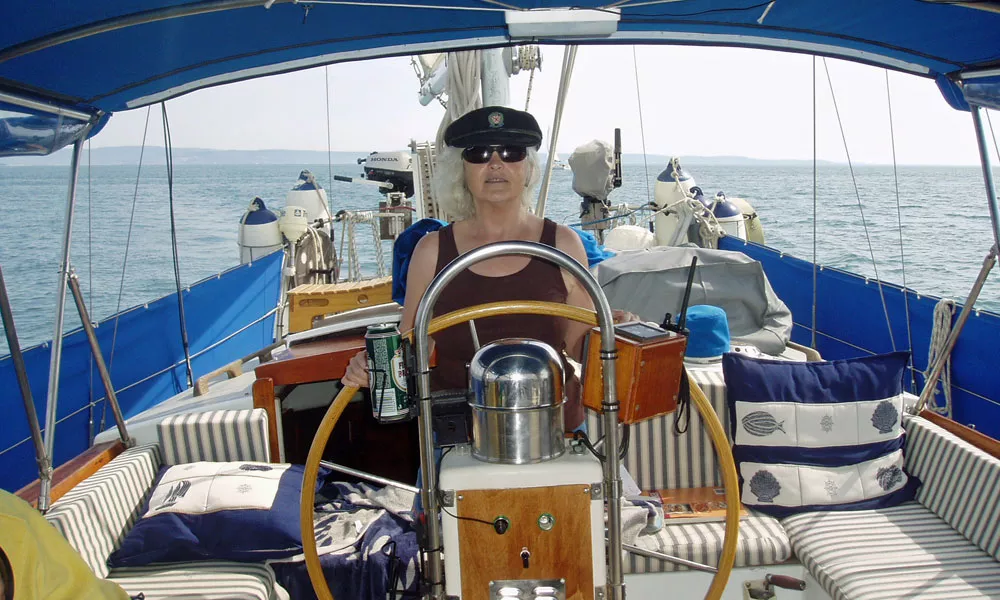
The Case for Sailboat Tillers as an Alternative To Wheel Steering
Just why do so many modern sailboats have wheel steering when sailboat tillers are cheaper, more reliable and convenient? Check out this comparison between wheels and tillers
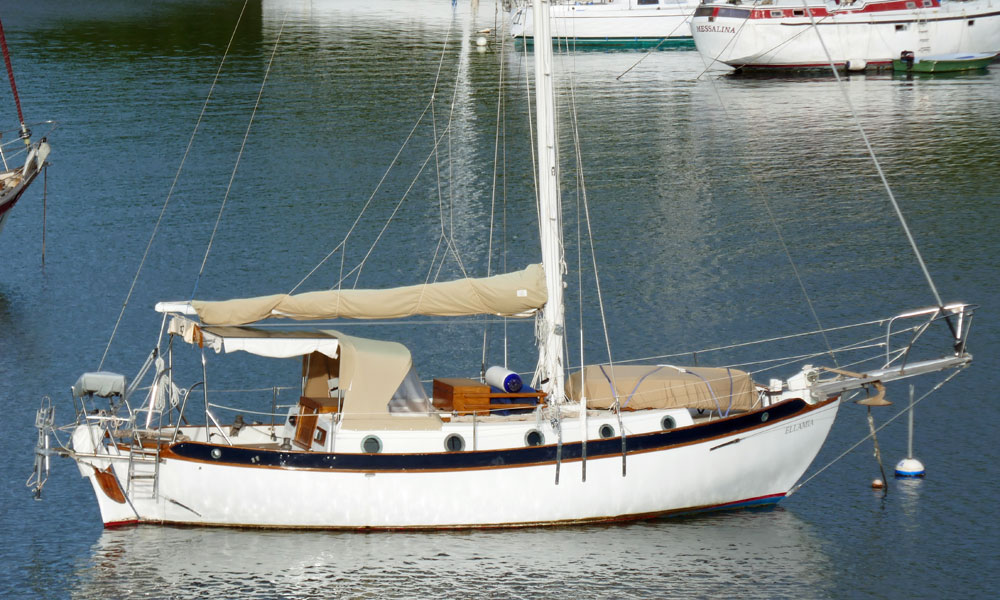
Are Heavy Displacement Hulls the Best Choice for Offshore Cruising?
Increasingly, offshore sailboat skippers are choosing moderate displacement hull forms in preference to heavier vessels when planning for an ocean crossing. And here's why...
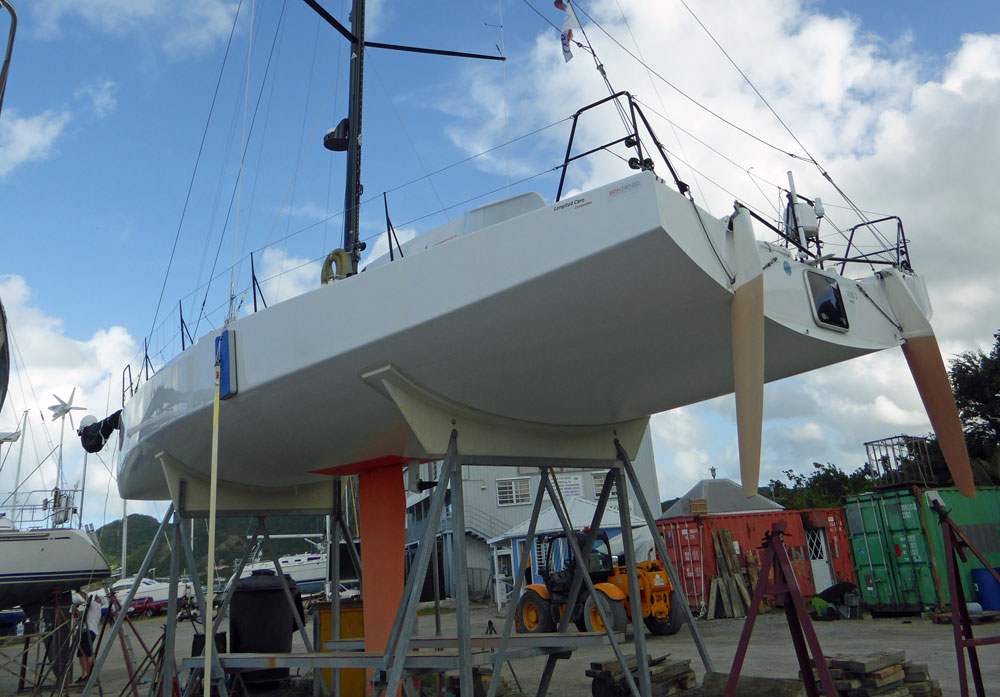
Sailboat Rudders
Illustrated examples of Balanced Sailboat Rudders, Semi-Balanced Rudders, Keel-Hung Rudders, Skeg-Hung Rudders, Spade Rudders, Twin Rudders, and Transom-Hung Rudders
A Sailboat Cockpit Must be Workable, Comfortable and Safe
The sailboat cockpit has to operate as an efficient work station when underway, and a comfortable leisure area when at anchor, but on some sailboats the compromise is not always successful
Recent Articles
The CSY 44 Mid-Cockpit Sailboat
Sep 15, 24 08:18 AM
Hallberg-Rassy 41 Specs & Key Performance Indicators
Sep 14, 24 03:41 AM
Amel Kirk 36 Sailboat Specs & Key Performance Indicators
Sep 07, 24 03:38 PM
Here's where to:
- Find Used Sailboats for Sale...
- Find Used Sailing Gear for Sale...
- List your Sailboat for Sale...
- List your Used Sailing Gear...
Our eBooks...

A few of our Most Popular Pages...

Copyright © 2024 Dick McClary Sailboat-Cruising.com

- Compare Sailboats
Sailboat Calculators
- Bluewater Sailboats
- Catamarans and Multihulls
- Sailing Liveaboard
- Sailboats Galley
- How Much it Costs
- Sailing Destinations
- Meteorology Terms
- Sailing and Nautical Terms
- Parts of a Sailboat
- Great Explorers
- People of the Seas
The Sailboats Calculators below will enable you to calculate the main Sailboat Ratios, using data that you can retrieve from the Boat table or your own data.
We will be adding more calculators along the way and more in-depth explanations of how they work and what they can help you with., hopefully you will enjoy them and find them useful to search or understand the characteristics of your or any given sailboat ..

SA/D range of values
16 to 18 Heavy offshore cruisers 18 to 22 Medium cruisers 22 to 26 Inshore cruisers, racing boats 26 to 30+ Extreme racing boats
Ballast/Displacement:
A Ballast/Displacement ratio of 40 or more translates into a stiffer, more powerful boat that will be better able to stand up to the wind.
Displacement/Length:
The lower a boat’s Displacement/Length (LWL) ratio, the less power it takes to drive the boat to its nominal hull speed.
less than 100 = Ultralight;
100-200 = Light;
200-275 = Moderate;
275-350 = Heavy;
350+ = Ultraheavy;
Comfort Ratio:
This is a ratio created by Ted Brewer as a measure of motion comfort. It provides a reasonable comparison between yachts of similar size and type. It is based on the fact that the faster the motion the more upsetting it is to the average person. Consider, though, that the typical summertime coastal cruiser will rarely encounter the wind and seas that an ocean going yacht will meet.
Numbers below 20 indicate a lightweight racing boat;
20 to 30 indicates a coastal cruiser;
30 to 40 indicates a moderate bluewater cruising boat;
40 to 50 indicates a heavy bluewater boat ;
over 50 indicates an extremely heavy bluewater boat.
Comfort ratio = D ÷ (.65 x (.7 LWL + .3 LOA) x Beam^1.33), where displacement is expressed in pounds, and length is expressed in feet.
Capsize Screening Formula (CSF):
Designed to determine if a boat has blue water capability. The CSF compares beam with displacement since excess beam contributes to capsize and heavy displacement reduces capsize vulnerability. The boat is better suited for ocean passages (vs coastal cruising) if the result of the calculation is 2.0 or less. The lower the better.
Hull Speed Calculator
Hull speed calculator is a simple calculator that determines a vessel’s hull speed based on the length of the vessel’s waterline.
Boat Speed Calculator
The boat speed calculator calculates the top speed of a boat based on the boat’s power and her displacement. If you try to understand how fast a boat can go, this calculator will help you answer that. The boat speed calculator utilizes a constant known as Crouch constant which differs based on the type of the boat.
FOR MULTIHULLS ONLY:
Bn – bruce number:.
The Bruce Number is a power-to-weight ratio for relative speed potential for comparing two or more boats. It takes into consideration the displacement and sail area of main and jib. 100% fore-triangle only, no overlapping sails.
Chris White, “The Cruising Multihull”, (International Marine, Camden, Maine, 1997), states that a boat with a BN of less than 1.3 will be slow in light winds. A boat with a BN of 1.6 or greater is a boat that will be reefed often in offshore cruising.
Derek Harvey, “Multihulls for Cruising and Racing”, International Marine, Camden, Maine, 1991, states that a BN of 1 is generally accepted as the dividing line between so-called slow and fast multihulls.
BN = SA^0.5/(Disp. in pounds)^.333
Kelsall Sailing Performance (KSP):
Another measure of relative speed potential of a boat. It takes into consideration “reported” sail area, displacement and length at waterline. The higher the number the faster speed prediction for the boat. A cat with a number 0.6 is likely to sail 6kts in 10kts wind, a cat with a number of 0.7 is likely to sail at 7kts in 10kts wind.
KSP = (Lwl*SA÷D)^0.5*.05
Subscribe to our newsletter
Don’t miss new updates on your email.
© OceanWave Sail. All Rights Reserved 2022
Terms & Conditions – Privacy Policy – Cookie Policy
About Us – Privacy Policy
- New account
Forgot your password?
Lost your password? Please enter your email address. You will receive mail with link to set new password.
Back to login
Privacy Overview
| Cookie | Duration | Description |
|---|---|---|
| _GRECAPTCHA | 5 months 27 days | This cookie is set by the Google recaptcha service to identify bots to protect the website against malicious spam attacks. |
| apbct_cookies_test | session | CleanTalk sets this cookie to prevent spam on comments and forms and act as a complete anti-spam solution and firewall for the site. |
| apbct_page_hits | session | CleanTalk sets this cookie to prevent spam on comments and forms and act as a complete anti-spam solution and firewall for the site. |
| apbct_prev_referer | session | Functional cookie placed by CleanTalk Spam Protect to store referring IDs and prevent unauthorized spam from being sent from the website. |
| apbct_site_landing_ts | session | CleanTalk sets this cookie to prevent spam on comments and forms and act as a complete anti-spam solution and firewall for the site. |
| apbct_site_referer | 3 days | This cookie is placed by CleanTalk Spam Protect to prevent spam and to store the referrer page address which led the user to the website. |
| apbct_timestamp | session | CleanTalk sets this cookie to prevent spam on comments and forms and act as a complete anti-spam solution and firewall for the site. |
| apbct_urls | 3 days | This cookie is placed by CleanTalk Spam Protect to prevent spam and to store the addresses (urls) visited on the website. |
| cookielawinfo-checkbox-advertisement | 1 year | Set by the GDPR Cookie Consent plugin, this cookie is used to record the user consent for the cookies in the "Advertisement" category . |
| cookielawinfo-checkbox-analytics | 11 months | This cookie is set by GDPR Cookie Consent plugin. The cookie is used to store the user consent for the cookies in the category "Analytics". |
| cookielawinfo-checkbox-functional | 11 months | The cookie is set by GDPR cookie consent to record the user consent for the cookies in the category "Functional". |
| cookielawinfo-checkbox-necessary | 11 months | This cookie is set by GDPR Cookie Consent plugin. The cookies is used to store the user consent for the cookies in the category "Necessary". |
| cookielawinfo-checkbox-others | 11 months | This cookie is set by GDPR Cookie Consent plugin. The cookie is used to store the user consent for the cookies in the category "Other. |
| cookielawinfo-checkbox-performance | 11 months | This cookie is set by GDPR Cookie Consent plugin. The cookie is used to store the user consent for the cookies in the category "Performance". |
| CookieLawInfoConsent | 1 year | Records the default button state of the corresponding category & the status of CCPA. It works only in coordination with the primary cookie. |
| ct_checkjs | session | CleanTalk–Used to prevent spam on our comments and forms and acts as a complete anti-spam solution and firewall for this site. |
| ct_fkp_timestamp | session | CleanTalk sets this cookie to prevent spam on the site's comments/forms, and to act as a complete anti-spam solution and firewall for the site. |
| ct_pointer_data | session | CleanTalk sets this cookie to prevent spam on the site's comments/forms, and to act as a complete anti-spam solution and firewall for the site. |
| ct_ps_timestamp | session | CleanTalk sets this cookie to prevent spam on the site's comments/forms, and to act as a complete anti-spam solution and firewall for the site. |
| ct_sfw_pass_key | 1 month | CleanTalk sets this cookie to prevent spam on comments and forms and act as a complete anti-spam solution and firewall for the site. |
| ct_timezone | session | CleanTalk–Used to prevent spam on our comments and forms and acts as a complete anti-spam solution and firewall for this site. |
| elementor | never | This cookie is used by the website's WordPress theme. It allows the website owner to implement or change the website's content in real-time. |
| JSESSIONID | session | The JSESSIONID cookie is used by New Relic to store a session identifier so that New Relic can monitor session counts for an application. |
| viewed_cookie_policy | 11 months | The cookie is set by the GDPR Cookie Consent plugin and is used to store whether or not user has consented to the use of cookies. It does not store any personal data. |
| Cookie | Duration | Description |
|---|---|---|
| _zcsr_tmp | session | Zoho sets this cookie for the login function on the website. |
| Cookie | Duration | Description |
|---|---|---|
| __gads | 1 year 24 days | The __gads cookie, set by Google, is stored under DoubleClick domain and tracks the number of times users see an advert, measures the success of the campaign and calculates its revenue. This cookie can only be read from the domain they are set on and will not track any data while browsing through other sites. |
| _ga | 2 years | The _ga cookie, installed by Google Analytics, calculates visitor, session and campaign data and also keeps track of site usage for the site's analytics report. The cookie stores information anonymously and assigns a randomly generated number to recognize unique visitors. |
| _ga_SMBZQHCWN2 | 2 years | This cookie is installed by Google Analytics. |
| _ga_W40VWSXK09 | 2 years | This cookie is installed by Google Analytics. |
| _gat_gtag_UA_231294427_1 | 1 minute | Set by Google to distinguish users. |
| _gid | 1 day | Installed by Google Analytics, _gid cookie stores information on how visitors use a website, while also creating an analytics report of the website's performance. Some of the data that are collected include the number of visitors, their source, and the pages they visit anonymously. |
| CONSENT | 2 years | YouTube sets this cookie via embedded youtube-videos and registers anonymous statistical data. |
| Cookie | Duration | Description |
|---|---|---|
| test_cookie | 15 minutes | The test_cookie is set by doubleclick.net and is used to determine if the user's browser supports cookies. |
| Cookie | Duration | Description |
|---|---|---|
| __gpi | 1 year 24 days | No description |
| 1e5a17c8ab | session | No description available. |
| apbct_headless | session | No description |
| apbct_pixel_url | session | No description |
| ct_checked_emails | session | No description |
| ct_has_scrolled | session | No description |
| ct_screen_info | session | No description |
| ZCAMPAIGN_CSRF_TOKEN | session | No description available. |
13 Best Cruising Sailboats in 2023 & Why They're Better
If you're interested in long-distance exploration at sea, cruising sailboats are a popular choice. The best cruising sailboats are designed to provide comfort, durability, and seaworthiness. From high-performance cruisers with heirloom-quality materials to versatile boats, there's something in this lineup for your skill level and preference. These boats have raised the bar and are set to provide memorable sailing experiences.
The best cruising sailboats are:
Beneteau Oceanis Yacht 54
Jeanneau sun odyssey 490, x-yachts x49, dufour grand large 460, hallberg-rassy 340, tartan 4300, island packet 420, fountaine pajot saona 47, lagoon 450f, bavaria cruiser 46.
One aspect that sets these sailboats apart is their focus on innovation and performance. Let's take a closer look at the 13 best cruising sailboats of 2023 and explore what makes them stand out from the rest.
- These cruising sailboats feature spacious interiors, sturdy hulls, and versatile sail configurations.
- These sailboats are equipped with navigation and communication systems, as well as additional features such as watermakers, generators, and refrigeration systems.
- You can buy these boats for anything between $250,000 and $1.4 million or more.
- A cruiser is a type of sailboat that is generally larger and more comfortable than a racing sailboat.
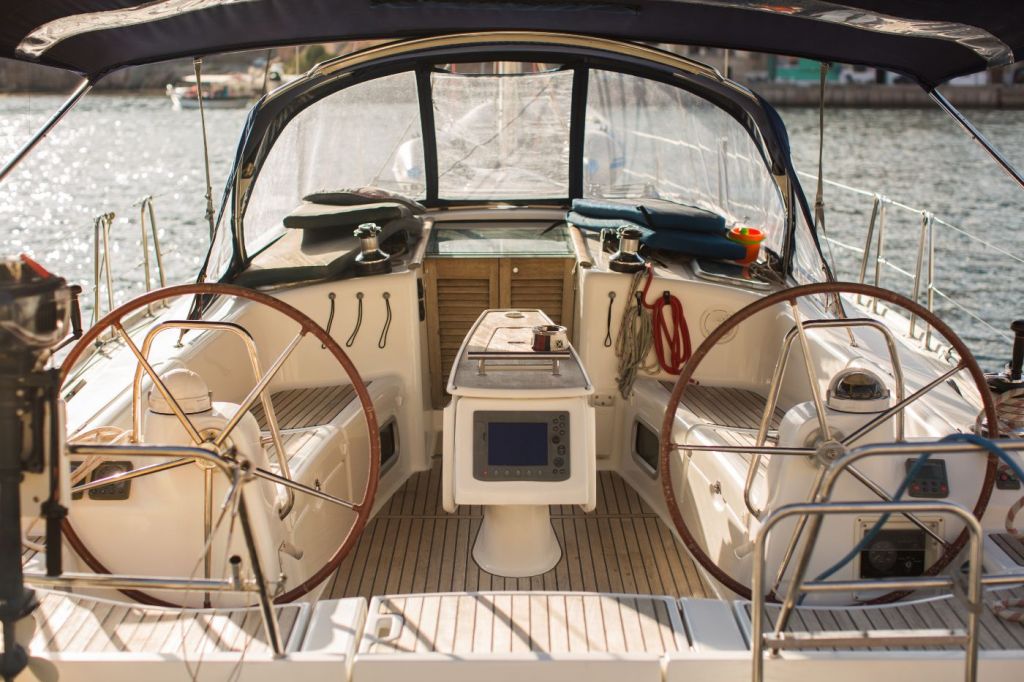
On this page:
Best cruising sailboats, why these sailboats are better, the most popular cruising sailboat.
| Size | Accommodation | Starting Price | |
|---|---|---|---|
| 50 feet | 6 to 8 people | $1.3 million | |
| 56.5 feet | 6 to 8 people | $1.4 million | |
| 54 feet | 6 to 8 people | $690,000 | |
| 49 feet | 6 to 8 people | $425,000 | |
| 49 feet | 6 to 8 people | $1.2 million | |
| 46 feet | 6 to 8 people | $370,000 | |
| 45.8 feet | 6 to 8 people | $350,000 | |
| 34 feet | 4 to 5 people | $300,000 | |
| 43 feet | 6 to 8 people | $600,000 | |
| 42 feet | 6 to 8 people | $550,000 | |
| 47 feet | 8 to 10 people | $900,000 | |
| 45 feet | 8 to 10 people | $700,000 | |
| 46 feet | 6 to 8 people | $250,000 |
In this section, we'll explore the 13 best cruising sailboats of 2023, highlighting their unique features and reasons why they stand out in the market.
| Living Space | Seaworthiness | Sailing Performance | Safety | Storage Space | Energy Efficiency | Durability | |
|---|---|---|---|---|---|---|---|
| 5 | 5 | 4 | 5 | 5 | 5 | 5 | |
| 5 | 5 | 4 | 5 | 5 | 4 | 5 | |
| 5 | 4 | 4 | 4 | 5 | 4 | 4 | |
| 4 | 4 | 4 | 4 | 5 | 4 | 4 | |
| 3 | 5 | 5 | 4 | 4 | 4 | 5 | |
| 5 | 4 | 4 | 4 | 5 | 4 | 4 | |
| 4 | 4 | 5 | 4 | 4 | 4 | 4 | |
| 4 | 5 | 4 | 4 | 4 | 4 | 5 | |
| 4 | 4 | 4 | 4 | 4 | 4 | 5 | |
| 4 | 5 | 3 | 4 | 5 | 3 | 5 | |
| 5 | 4 | 4 | 4 | 5 | 4 | 4 | |
| 5 | 4 | 4 | 4 | 5 | 4 | 4 | |
| 4 | 4 | 4 | 4 | 4 | 5 | 4 |
Comfortable living space : A cruising sailboat should have a comfortable living space that can accommodate the crew for an extended period of time. This includes a spacious cabin, galley, head, and berths.
Seaworthiness : A cruising sailboat should be able to handle rough seas and adverse weather conditions. It should have a sturdy hull, a well-designed keel, and a balanced rigging system.
Sailing performance : A cruising sailboat should have good sailing performance, which includes speed, stability, and ease of handling. It should be able to sail efficiently in different wind conditions.
Safety features : A cruising sailboat should have safety features such as a reliable navigation system, adequate safety equipment, and a strong anchoring system.
Storage space : A cruising sailboat should have enough storage space for provisions, equipment, and personal belongings. This includes storage lockers, shelves, and compartments.
Energy efficiency : A cruising sailboat should have an energy-efficient system that can provide power for lighting, electronics, and other equipment without relying on shore power.
Durability : A cruising sailboat should be built to last and withstand the wear and tear of extended cruising. This includes using high-quality materials and construction techniques.
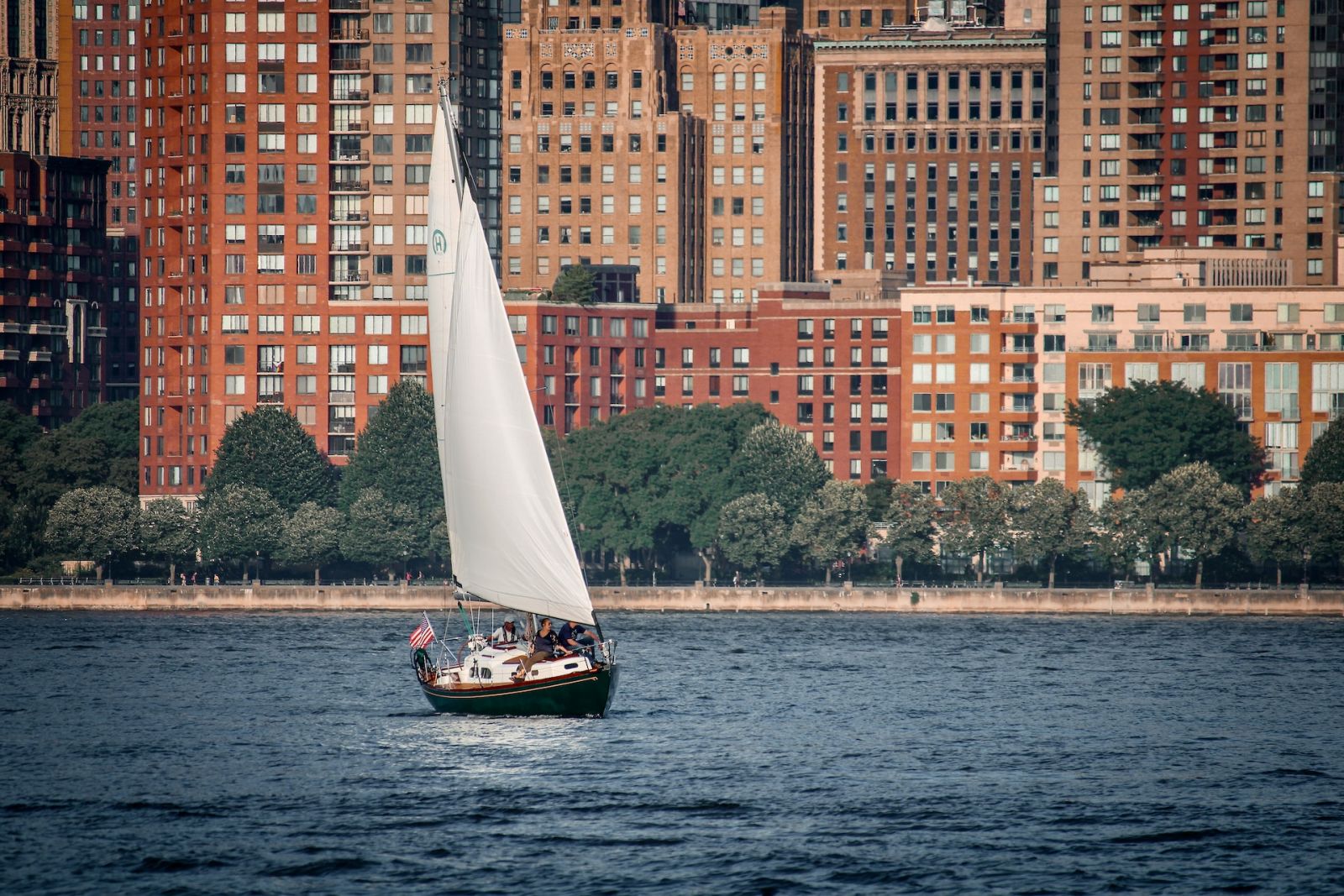
The Amel 50 is known for its luxurious and comfortable accommodations, and excellent seaworthiness. Its unique features include a spacious interior with modern design, an innovative cockpit layout, and a powerful yet easy-to-handle sailing system.
The Amel 50 has a unique feature called the "Amel Easy Docking" system, which allows for easy and precise maneuvering in tight spaces. It also has a unique "Amel Silent Block" system, which reduces noise and vibration for a more comfortable ride.
The Oyster 565 is known for its high-quality construction, attention to detail, and luxurious accommodations, as well as its excellent safety features. It provides you with exceptional performance and comfort. Its sleek hull design offers fast, stable sailing, while the spacious, high-quality interior ensures you'll enjoy your time onboard.
The Oyster 565 has a unique feature called the "Oyster Deck Saloon," which provides 360-degree views and adequate natural light in the living space. It also has a unique "Oyster DNA" system, which allows for customization of the boat to suit the owner's preferences.
With its cutting-edge design and performance, the Beneteau Oceanis Yacht 54 lets you sail in style. Its chined hull, twin rudders, and easy handling make it a pleasure to sail, while the spacious, modern interior ensures your comfort on longer voyages.
The Beneteau Oceanis Yacht 54 has a unique feature called the "Dock & Go" system, which allows for easy and precise maneuvering in tight spaces. It also has a unique "Beneteau Smart Sailing" system, which includes a suite of electronic and navigational tools for easy and safe sailing.
The Jeanneau Sun Odyssey 490 is known for its hard chine design, and excellent performance and stability. It offers innovative design and functionality. Its walk-around decks, unique cockpit layout, and high-quality interior make it ideal for cruising in comfort.
The Jeanneau Sun Odyssey 490 has a unique feature called the "Walk-Around Deck," which allows for easy and safe movement around the boat. It also has a unique "Jeanneau Sun Loft" system, which provides a flexible and customizable living space.
The X-Yachts X49 combines performance, luxury, and comfort. It is known for its high-performance hull design, excellent speed and stability. With its fast hull, advanced sailing systems, and plush interior, the X49 is perfect for both racing and cruising.
The X-Yachts X49 has a unique feature called the "X-Yachts Pure X" system, which includes a suite of performance-enhancing features such as a carbon fiber mast and boom, a racing-inspired sail plan, and a deep lead keel.
The Dufour Grand Large 460 provides you with both comfort and performance. It is known for its innovative design, featuring a self-tacking jib and retractable bow thruster for easy handling. Its spacious interior, ergonomic deck layout, and powerful sailing capabilities make it an excellent choice for long-distance cruising.
The Dufour Grand Large 460 has a unique feature called the "Dufour Easy" system, which includes a suite of tools for easy and safe sailing, such as a self-tacking jib and retractable bow thruster. It also has a unique "Dufour Grand Large Lounge" system, which provides a flexible and customizable living space.
Experience easy handling and modern style with the Hanse 458. It is known for its sleek and modern design, self-tacking jib, large swim platform. Its innovative self-tacking jib, efficient deck layout, and comfortable accommodation make it perfect for family cruising.
The Hanse 458 has a unique feature called the "Hanse Easy Sailing" system, which includes a suite of tools for easy and safe sailing, such as a self-tacking jib and retractable bow thruster. It also has a unique "Hanse Individual Cabin Concept" system, which allows for customization of the living space to suit the owner's preferences.
Known for its quality and craftsmanship, the Hallberg-Rassy 340 offers you comfort and performance in a compact package. It is known for its classic design, long waterline, spacious cockpit, and comfortable and practical accommodations. With its stable hull, efficient sailplan, and well-designed interior, it's ideal for long-range cruising on a smaller scale.
The Hallberg-Rassy 340 has a unique feature called the "Hallberg-Rassy Hardtop," which provides protection from the elements and a spacious cockpit area. It also has a unique "Hallberg-Rassy Quality Concept" system, which includes high-quality construction materials and techniques for durability and longevity.
The Tartan 4300 delivers a perfect balance of performance and comfort. It is known for its high-quality construction, cored hull and deck for added strength and durability. Its epoxy-infused hull provides lightweight strength, while the spacious, beautifully crafted interior ensures a luxurious cruising experience.
The Tartan 4300 has a unique feature called the "Tartan Infusion Molding Process," which allows for precise and consistent construction of the hull and deck for added strength and durability. It also has a unique "Tartan Smart Sailing" system, which includes a suite of electronic and navigational tools for easy and safe sailing.
For those who value comfort and classic design, the Island Packet 420 won't disappoint. It is known for its full keel design, excellent stability and seaworthiness. Its spacious, well-appointed interior and solid construction make it a reliable choice for long voyages.
The Island Packet 420 has a unique feature called the "Island Packet Full Foil Keel," which provides excellent stability and seaworthiness. It also has a unique "Island Packet Anchoring System," which includes a powerful windlass and a custom-designed anchor roller for easy and safe anchoring.
The Fountaine Pajot Saona 47 catamaran offers you the perfect combination of speed, stability, and space. Its sleek hulls and spacious, well-designed living areas make it an excellent choice for cruising with friends and family.
The Fountaine Pajot Saona 47 has a unique feature called the "Fountaine Pajot Helmsman's Position," which provides excellent visibility and control of the boat. It also has a unique "Fountaine Pajot Lounge Deck" system, which provides a spacious and comfortable living space.
Cruise in style on the Lagoon 450F, known for its spacious accommodations and excellent performance under sail. With its distinctive flybridge, comfortable cabins, and efficient sailing system, it's ideal for multi-day getaways.
The Lagoon 450F has a unique feature called the "Lagoon Flybridge," which provides excellent visibility and control of the boat. It also has a unique "Lagoon Spacious Cockpit" system, which provides a comfortable and practical living space.
The Bavaria Cruiser 46 is a versatile and stylish cruiser that offers excellent performance and comfort. It is known for its innovative design, featuring a drop-down transom for easy access to the water. Its user-friendly sailing systems, attractive interior, and practical deck layout make it an ideal choice for a wide range of cruising adventures.
The Bavaria Cruiser 46 has a unique feature called the "Bavaria Hybrid Propulsion System," which allows for energy-efficient sailing and propulsion. It also has a unique "Bavaria Smart Storage" system, which provides enough storage space for gear and supplies. Additionally, the Bavaria Cruiser 46 has a unique "Bavaria Vision" design concept, which includes a spacious and comfortable living space with plenty of natural light and ventilation.
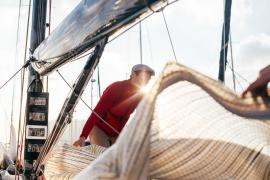
Cruising Gear Essentials
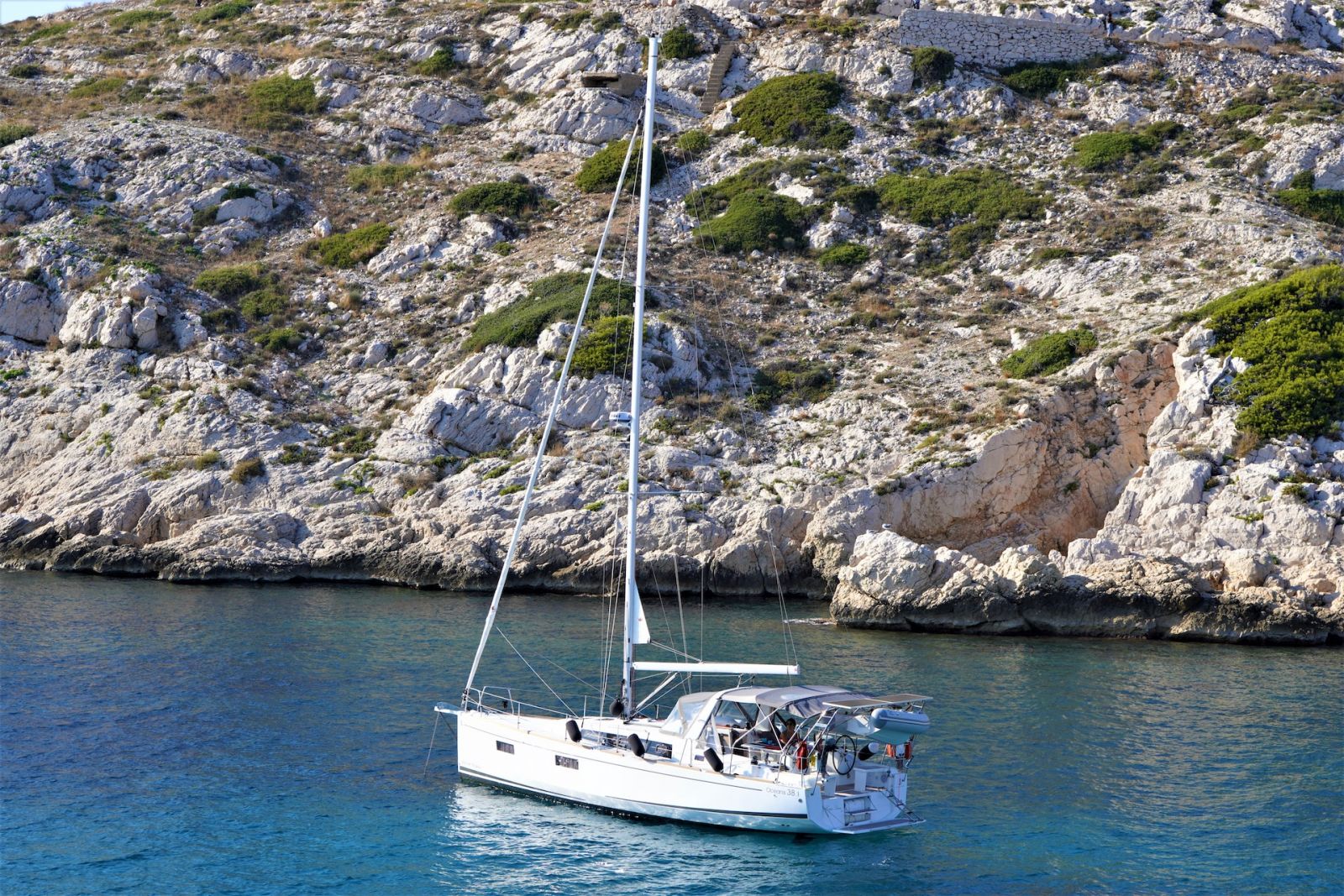
Key features to look for
Versatile hull design.
This allows your sailboat to navigate in various conditions, making it ideal for long-distance cruising.
Efficient sail plan
By having a well-designed sail layout, your boat provides better control, handling, and propulsion.
High-quality construction
Top-quality materials and craftsmanship not only increase the boat's durability, but also enhance its performance.
Comfortable accommodations
When you spend extended periods at sea, you want your sailboat to feel like home, with adequate living space and modern amenities. For an extended sailing trip, you are going to need these 41 sailboat cruising essentials .

How they improve sailing experience
Easier boat handling.
Advanced rigging systems, self-tacking jibs, and other innovative technologies make it easier for you to manage your boat, allowing for more time spent enjoying the sea.
Increased safety
State-of-the-art navigation equipment and weather forecasting systems help you anticipate environmental changes, ensuring a safe voyage.
Sustainable power options
Many sailboats in 2023 come with solar panels, hydro generators, or hybrid propulsion options, reducing your environmental impact and providing more sustainable choices while out at sea.
Integrated connectivity
These boats boast digital systems that allow you to stay connected, monitor your journey, and update your friends and family with your adventures.
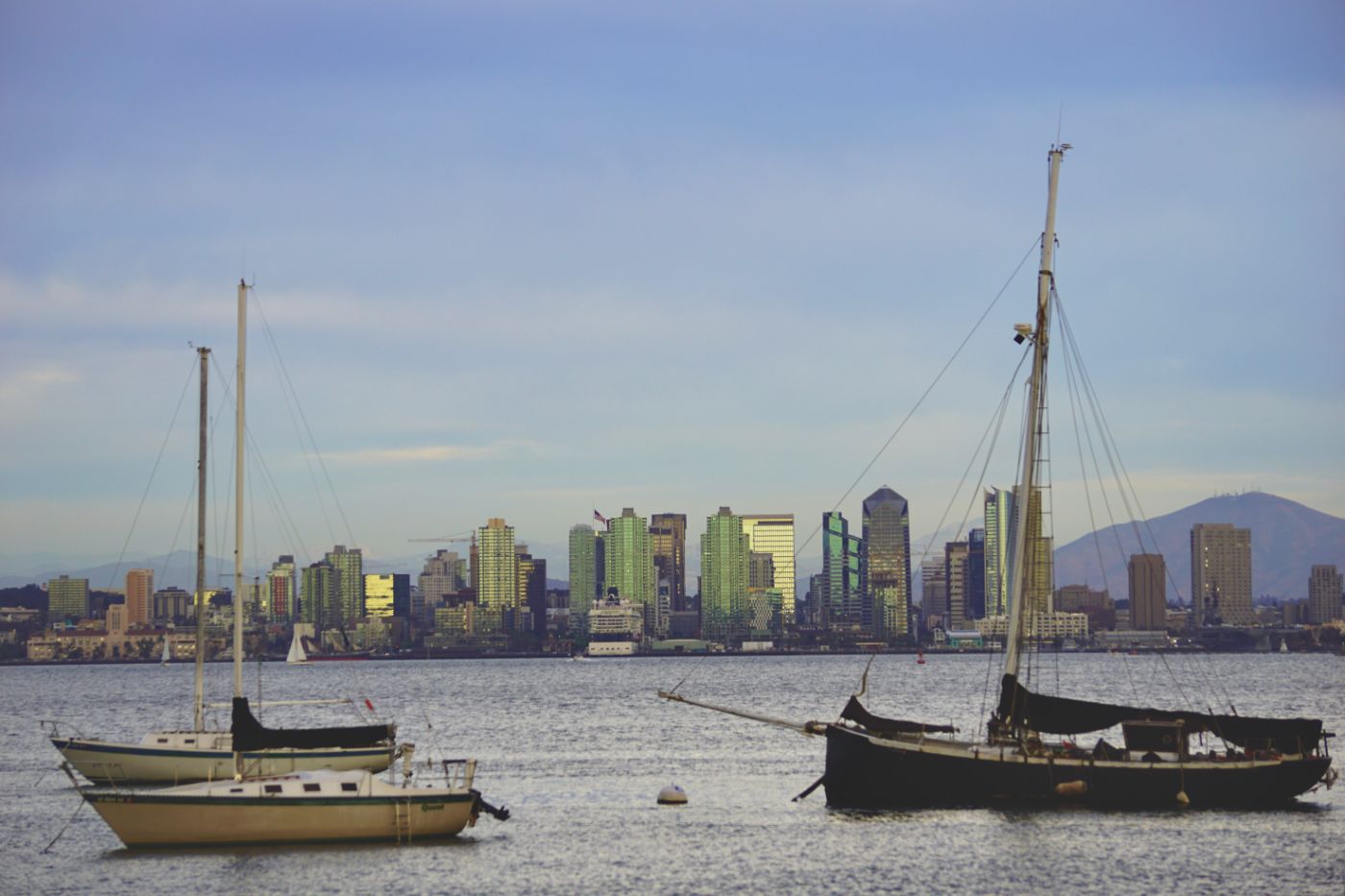
Their advantages over others
Better performance.
These boats have been designed with speed, stability, and maneuverability in mind, ensuring top-notch sailing experiences.
Longevity and value
Since they're built with high-quality materials and expert craftsmanship, these boats are certain to last, making them a wise investment.
Customization options
Many of these sailboats offer customizable features, allowing you to tailor the boat to your specific needs and preferences.
Award-winning designs
Several of these boats have received prestigious awards for their innovative features and performance, making them the ultimate cruising sailboats for any passionate sailor.
The Island Packet 420 and Lagoon 450F are the two most popular cruising sailboats known for their comfort, seaworthiness, and versatility.
The Island Packet 420 is a well-regarded cruising sailboat that has a loyal following. It is known for its spacious interior, comfortable accommodations, and good sailing performance.
The Island Packet 420 features a full keel and a cutter rig, which makes it a stable and seaworthy vessel that can handle a variety of weather conditions. The sailboat has a large master cabin, a well-equipped galley, and a comfortable salon area, making it a popular choice for those who enjoy extended periods of time at sea.
The Lagoon 450F is a popular choice for those who want to explore the world by boat. It is known for its spacious interior, stable platform, and good sailing performance.
The Lagoon 450F features a catamaran hull design, which provides a stable and comfortable platform that is ideal for long-distance cruising. The sailboat has a spacious cockpit, multiple sleeping quarters, and a well-equipped galley, making it a popular choice for those who want to travel with family or friends.
The best size cruising sailboat
The best size cruising sailboat is in the range of 40 to 50 feet. Sailboats in this size range are large enough to provide comfortable accommodations for an extended period of time at sea, yet small enough to be easily handled by a small crew or even single-handed.
Sailboats that are too small may lack the necessary amenities and space for long-distance cruising, while sailboats that are too large may be difficult to handle and require a larger crew. Ultimately, the best size cruising sailboat will depend on individual preferences, needs, and intended use, and it's important to consider factors such as comfort, safety, and ease of handling when choosing a cruising sailboat.
The safest cruising sailboat
Hallberg-Rassy 340, and Island Packet 420 are considered among the safest cruising sailboats. These sailboats are known for their sturdy construction, well-designed hulls, and reliable systems. They are also known for their ability to handle a variety of weather conditions and their comfortable accommodations. However, safety can also depend on the boat maintenance, and the skill and experience of the crew.
Leave a comment
You may also like, 41 sailboat cruising essentials for long trips.
In this post I list the items you are unlikely to have if you have never done bluewater or long-term cruising before. There are some essential safety product and …
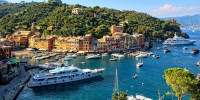
What's the Best Size of Sailboat for Coastal Cruising?

The Best Boat for Cruising the Mediterranean (3 Types)
The best beginner sailboats for ocean cruising (under $25,000).
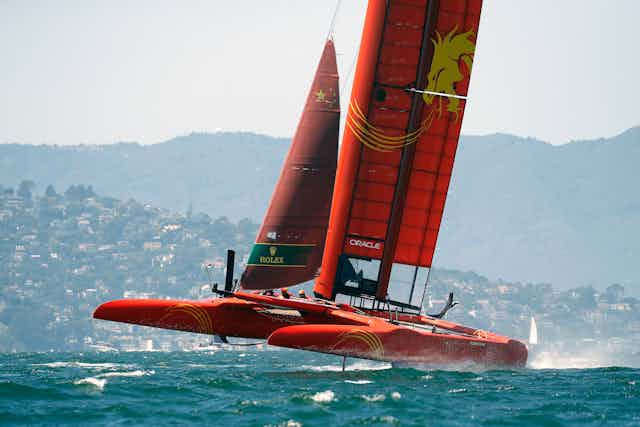
Sail GP: how do supercharged racing yachts go so fast? An engineer explains
Head of Engineering, Warsash School of Maritime Science and Engineering, Solent University
Disclosure statement
Jonathan Ridley does not work for, consult, own shares in or receive funding from any company or organisation that would benefit from this article, and has disclosed no relevant affiliations beyond their academic appointment.
View all partners
Sailing used to be considered as a rather sedate pastime. But in the past few years, the world of yacht racing has been revolutionised by the arrival of hydrofoil-supported catamarans, known as “foilers”. These vessels, more akin to high-performance aircraft than yachts, combine the laws of aerodynamics and hydrodynamics to create vessels capable of speeds of up to 50 knots, which is far faster than the wind propelling them.
An F50 catamaran preparing for the Sail GP series recently even broke this barrier, reaching an incredible speed of 50.22 knots (57.8mph) purely powered by the wind. This was achieved in a wind of just 19.3 knots (22.2mph). F50s are 15-metre-long, 8.8-metre-wide hydrofoil catamarans propelled by rigid sails and capable of such astounding speeds that Sail GP has been called the “ Formula One of sailing ”. How are these yachts able to go so fast? The answer lies in some simple fluid dynamics.
As a vessel’s hull moves through the water, there are two primary physical mechanisms that create drag and slow the vessel down. To build a faster boat you have to find ways to overcome the drag force.
The first mechanism is friction. As the water flows past the hull, a microscopic layer of water is effectively attached to the hull and is pulled along with the yacht. A second layer of water then attaches to the first layer, and the sliding or shearing between them creates friction.
On the outside of this is a third layer, which slides over the inner layers creating more friction, and so on. Together, these layers are known as the boundary layer – and it’s the shearing of the boundary layer’s molecules against each other that creates frictional drag.
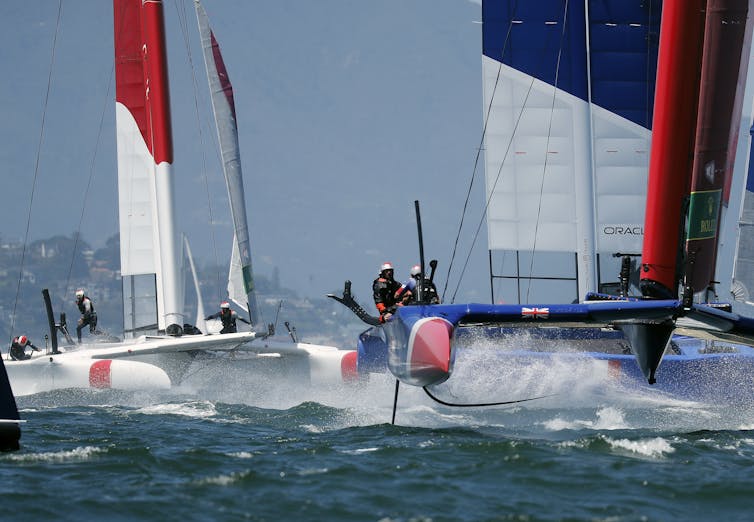
A yacht also makes waves as it pushes the water around and under the hull from the bow (front) to the stern (back) of the boat. The waves form two distinctive patterns around the yacht (one at each end), known as Kelvin Wave patterns.
These waves, which move at the same speed as the yacht, are very energetic. This creates drag on the boat known as the wave-making drag, which is responsible for around 90% of the total drag. As the yacht accelerates to faster speeds (close to the “hull speed”, explained later), these waves get higher and longer.
These two effects combine to produce a phenomenon known as “ hull speed ”, which is the fastest the boat can travel – and in conventional single-hull yachts it is very slow. A single-hull yacht of the same size as the F50 has a hull speed of around 12 mph.
However, it’s possible to reduce both the frictional and wave-making drag and overcome this hull-speed limit by building a yacht with hydrofoils . Hydrofoils are small, underwater wings. These act in the same way as an aircraft wing, creating a lift force which acts against gravity, lifting our yacht upwards so that the hull is clear of the water.

While an aircraft’s wings are very large, the high density of water compared to air means that we only need very small hydrofoils to produce a lot of the important lift force. A hydrofoil just the size of three A3 sheets of paper, when moving at just 10 mph, can produce enough lift to pick up a large person.
This significantly reduces the surface area and the volume of the boat that is underwater, which cuts the frictional drag and the wave-making drag, respectively. The combined effect is a reduction in the overall drag to a fraction of its original amount, so that the yacht is capable of sailing much faster than it could without hydrofoils.
The other innovation that helps boost the speed of racing yachts is the use of rigid sails . The power available from traditional sails to drive the boat forward is relatively small, limited by the fact that the sail’s forces have to act in equilibrium with a range of other forces, and that fabric sails do not make an ideal shape for creating power. Rigid sails, which are very similar in design to an aircraft wing, form a much more efficient shape than traditional sails, effectively giving the yacht a larger engine and more power.
As the yacht accelerates from the driving force of these sails, it experiences what is known as “ apparent wind ”. Imagine a completely calm day, with no wind. As you walk, you experience a breeze in your face at the same speed that you are walking. If there was a wind blowing too, you would feel a mixture of the real (or “true” wind) and the breeze you have generated.
The two together form the apparent wind, which can be faster than the true wind. If there is enough true wind combined with this apparent wind, then significant force and power can be generated from the sail to propel the yacht, so it can easily sail faster than the wind speed itself.
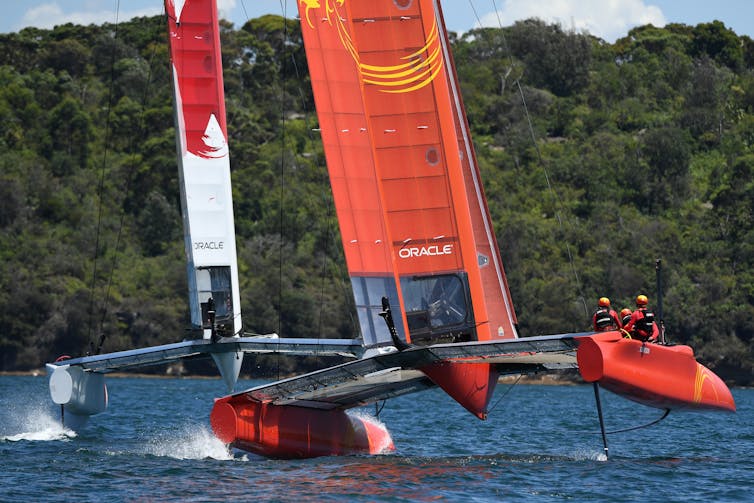
The combined effect of reducing the drag and increasing the driving power results in a yacht that is far faster than those of even a few years ago. But all of this would not be possible without one further advance: materials. In order to be able to “fly”, the yacht must have a low mass, and the hydrofoil itself must be very strong. To achieve the required mass, strength and rigidity using traditional boat-building materials such as wood or aluminium would be very difficult.
This is where modern advanced composite materials such as carbon fibre come in. Production techniques optimising weight, rigidity and strength allow the production of structures that are strong and light enough to produce incredible yachts like the F50.
The engineers who design these high-performance boats (known as naval architects ) are always looking to use new materials and science to get an optimum design. In theory, the F50 should be able to go even faster.
- Engineering
- Aerodynamics

Research Fellow Community & Consumer Engaged Health Professions Education

Professor of Indigenous Cultural and Creative Industries (Identified)

Communications Director

University Relations Manager

2024 Vice-Chancellor's Research Fellowships
CNN values your feedback
Syroco vs sp80: the race to create the world’s fastest sail boat.

Syroco vs SP80: groundbreaking ship design
For more than eight years, the world sailing speed record has remained unbroken.
In November 2012, Australian Paul Larsen reached 65.45 knots (or 121 kilometers per hour/75 mph) in his Vesta Sailrocket 2 in South Atlantic waters off the coast of Namibia.
However, two rival teams, one in France and one in Switzerland, are now striving relentlessly towards the same goal: to create the fastest sailboat ever built.
One is headed by the former world title holder, and there are two brothers involved – but on opposing teams.

Return to glory?
Setting speed records on water isn’t a new thing for Alex Caizergues, 41, a four-time kite speed world champion from France.
In 2010, Caizergues became the first person ever to pass the 100 kilometer-per-hour mark sailing on wind power alone.
With this feat, he also set a new world speed sailing record. A short-lived reign, since he was dethroned, just a few days later, by fellow Frenchman and kiteboarder Sebastien Cattelan.
But now Alex Caizergues has enlisted a team of extreme sports athletes, tech entrepreneurs and financiers to help him claim it back.
The science of frictionless sailing
The sirocco is a warm wind originating in the sandy expanses of the Saharan desert. Well known to sailors all over the Mediterranean, this occasionally ferocious southeasterly wind lends its name to Caizergues’ project.
Based in the port city of Marseilles, maritime technology startup Syroco is working on a wind-powered boat able to break the 80 knots barrier, equivalent to 150 kilometers per hour.
But first of all, let’s forget about the traditional sailing boat concept.
Syroco is nothing of the sort: It’s essentially a six-meter-long fish-shaped capsule pulled by a kite.
Film festival invites fans to watch movies alone on a Swedish island
The capsule is suspended a few feet above the surface of the water. It would almost be flying, were it not for a retractable arm attached to a submerged foil, which provides stability and direction as well as the only point of contact with the water.
The two people sitting inside the capsule will have the task of controlling both the kite and the foil for optimal balance and movement – not an easy task when skimming the surface of the sea at 80 knots.
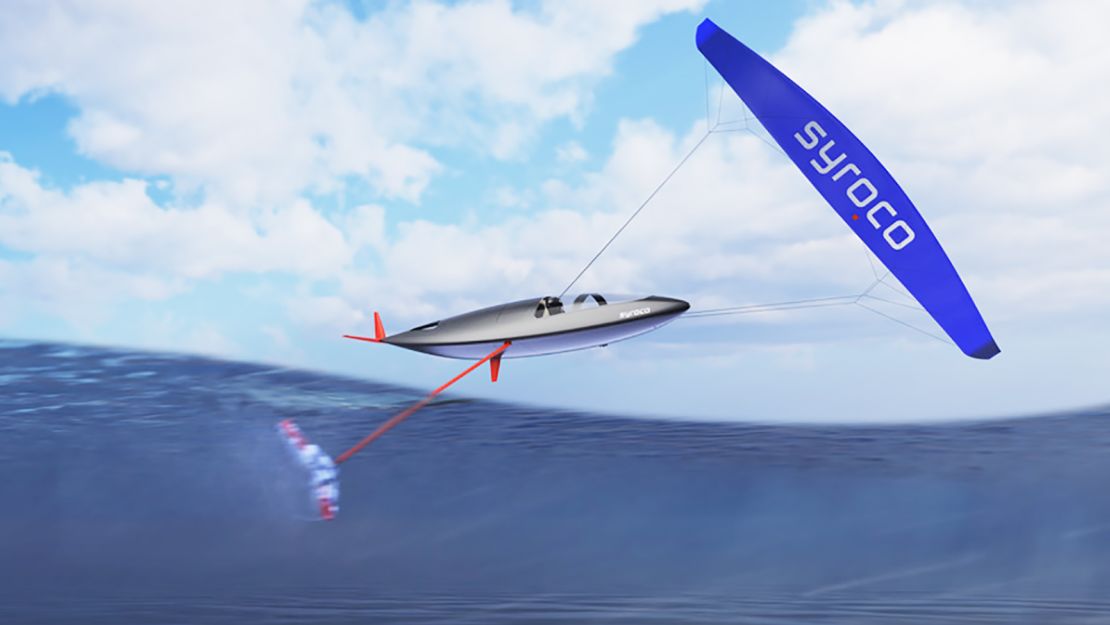
Aerodynamics and fluid physics
Caizergues tells CNN Travel he’s confident that, all going to plan, he’ll be able to make a first record-breaking attempt in early 2022.
Before then, Syroco’s first step will be to test a radio-controlled exact replica, which will be one quarter of the size of the real thing and should be ready early this year.
Syroco’s eye-catching, stylized design is the result of extensive research in the fields of aerodynamics and fluid physics.
It’s precisely from this engineering prowess that the startup hopes to derive most of the project’s value, since, rather than a one-off stunt, this record-breaking attempt will serve as a launchpad for more far-reaching ambitions
Moonshot approach
The idea is that Syroco will act as a long-term catalyst for innovation in the field of maritime technology. “We favor the moonshot approach; we want to stretch the technology envelope,” says Caizargues.
Syroco’s eclectic lineup of founders and early backers includes tech venture capitalists who are active in both France and Silicon Valley, an oceanic solo yachtsman, and the co-founder of a NASDAQ-listed software firm.
“It is not so much about setting a new record, as it is about developing new technologies that bring efficiency to the world of sailing,” says Yves de Montcheuil, one of Syroco’s co-founders, before highlighting the project’s environmental credentials.
“The work we do here in fields such as supercavitation have many industrial applications and can help the shipping industry reduce emissions by making ships more efficient.”
Cavitation is a physical phenomenon that takes place when, under certain speed conditions, bubbles form around objects that move in water. When pressure changes and these bubbles collapse, they produce a shock wave that can damage surfaces exposed to it, such as ships’ propellers.
However, engineers have learned to use cavitation to produce a bubble-like effect that envelops underwater objects, reducing friction and allowing them to move at high speeds. This is the so-called supercavitation, a technology which is used by some advanced torpedoes and propellers.
Syroco expects to be able to commercialize the data and know-how it acquires in this area, for example in developing computerized simulations, and it is already starting to cooperate with shipyards and other players in the shipping industry to deploy them in industrial applications.
The race is on
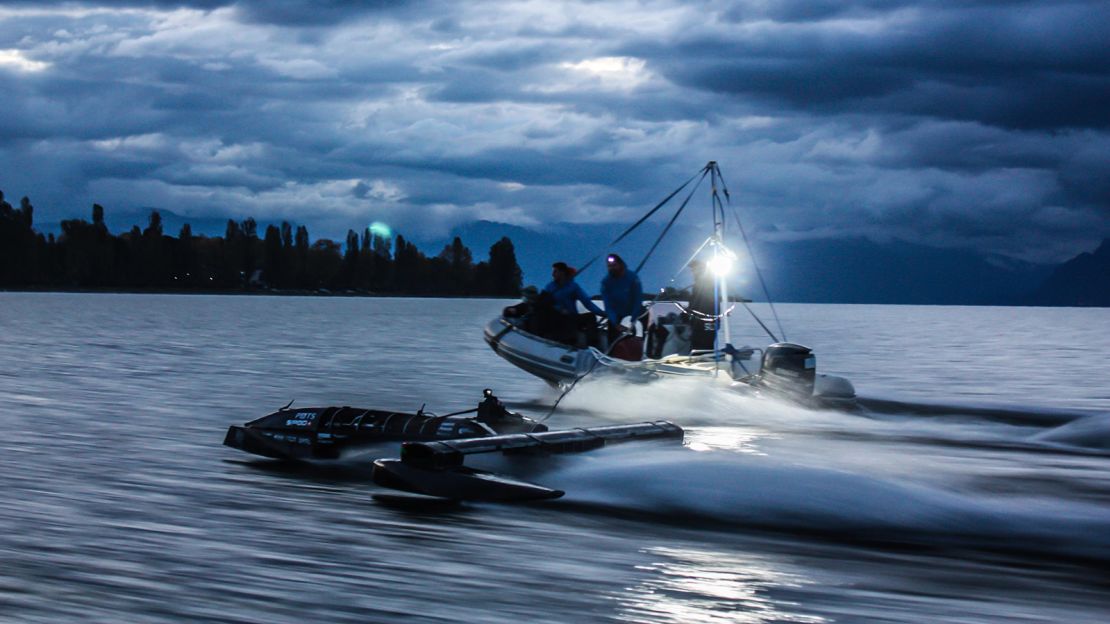
Another, so far speculative, line of thought is whether this endeavor could evolve into a new sport franchise: a sort of Formula One on water, in which high-tech superfast sailboats might compete regularly with each other.
If this was the case, Syroco’s team may soon find a worthy rival in the SP80, a project started in 2019 by three graduates of the École Polytechnique Fédérale de Lausanne, a prestigious Swiss engineering school, which is also supporting its development.
The team is based just a few hundred miles north of Caizergues’ Marseilles operation.
While similar in appearance to Syroco’s concept, in this case the central capsule isn’t lifted above the water but skims the surface with help from two lateral foils protruding from each side.
Like breaking the sound barrier
“This is the constructive solution that allows you to overcome the issue of cavitation,” co-founder Mayeul van den Broek tells CNN Travel. “This is one of the reasons it is difficult for conventional ships to sail faster than 40 or 50 knots; it is a bit akin to trying to break the sound barrier in a plane.”
The SP80 team is currently focused on breaking the record, rather than in finding longer-term applications for its technology, but aside from that, it’s aiming for the same 80-knot barrier as Syroco and within a similar time-frame.
“Of course we know each other,” says van den Broek, when asked about the competition between the two projects, before revealing that SP80 co-founder Benoit Gaudiot is the brother of Syroco engineer Thomas Gaudiot.
“There is some rivalry to beat the record, but I think rivalry also spurs both teams,” says van den Broek. “It will also help us get the word out, raise awareness about what we are trying to do here.”
Show all
'.concat(e,"
'.concat(i,"
Automatically renews at ').concat(n.labelSubtext,"/").concat(n.billingInterval," . Cancel anytime.
\n ').concat(n,'\n
\n ').concat(t,'\n
This page will automatically redirect in 5 seconds...
').concat(o).concat(n,"
\n '+(null!=(o=r(e,"if").call(u,null!=n?r(n,"cta2PreText"):n,{name:"if",hash:{},fn:l.program(20,t,0),inverse:l.noop,data:t,loc:{start:{line:29,column:20},end:{line:29,column:61}}}))?o:"")+"\n"+(null!=(o=(r(e,"ifAll")||n&&r(n,"ifAll")||l.hooks.helperMissing).call(u,null!=n?r(n,"cta2Text"):n,null!=n?r(n,"cta2Link"):n,{name:"ifAll",hash:{},fn:l.program(22,t,0),inverse:l.noop,data:t,loc:{start:{line:30,column:20},end:{line:35,column:30}}}))?o:"")+"
\n \n '+i((u=null!=(u=p(e,"title")||(null!=n?p(n,"title"):n))?u:c,(0,_typeof2.default)(u)===s?u.call(r,{name:"title",hash:{},data:t,loc:{start:{line:20,column:73},end:{line:20,column:82}}}):u))+" \n "+i((u=null!=(u=p(e,"subtext")||(null!=n?p(n,"subtext"):n))?u:c,(0,_typeof2.default)(u)===s?u.call(r,{name:"subtext",hash:{},data:t,loc:{start:{line:21,column:24},end:{line:21,column:35}}}):u))+"\n \n

How Fast Do Racing Sailboats Go?

Speed thrills, and in a sailboat, it thrills even more. Sailboat racers like to push their boats to the limit. But just how fast do racing sailboats go?
Sailboats come in a variety of shapes and sizes. If you are a speed enthusiast, you must wonder about the maximum speeds of different sailboats and if larger sailboats can go faster than smaller ones.
Racing sailboats usually skim over the water at around 15 to 20 knots. For comparison, the average speed of a traditional sailboat is only around 5 to 8 knots. Some custom-designed boats can reach record-breaking speeds of up to 50 or more knots.
Since sailboats don't rely on internal power for speed, many factors determine the speed of a sailboat, and every sailboat has different top speeds.
Experienced sailboat sailors believe that several factors influence the top speed. The size and shape of the boat, sails, and skill level all play a crucial role in determining the speed of a sailboat. Even more than the internal factors, external factors such as the waves and the wind can greatly boost or hinder sailboat speed.
Table of contents
What Influences Sailboat Speed
Sailboats have different shapes and sizes, and different sailboats can reach different speeds. There are many internal factors, such as those related directly to the boat, and external factors, such as weather, ocean currents, etc., that influence the speed of a sailboat.
Boat Size and Length
The most crucial thing that plays a role in speed is the sailboat's length and overall surface area. What does size have to do with speed, you ask? For a sailboat to go fast, you need to maximize the propulsion by the wind and keep drag and resistive forces to a minimum.
As the sailboat moves through the water, it generates waves. One wave that is created among others constantly rides with the boat. It has its peak just in front of the bow, while its trough is at the stern. If this wave is long enough, it can act as a wall of water to the boat.
The aerodynamic shape of the bow is designed to push up and rise above this wave. This allows the boat to lift the bow out of the water and rise above the water surface. As the bow rises, the stern gets pushed down into the water. This reduces the drag and also allows the boat to glide above waves.
But this wall of water creates resistance for the boat, and the sailboat requires power and momentum to break through this resistance. A larger sailboat has more momentum, which allows it to break through the barrier easily. This makes it possible for the larger boat to go faster.
You might think that a smaller boat is lighter and will offer less resistance and drag. Yes, this is true, but a smaller boat generates multiple small waves, which offer more resistance. Lightweight boats are also more susceptible to wind shear and tend to veer off course.
Different boats have different hull designs. The hulls are designed to be narrow and precisely engineered for racing sailboats to offer minimum resistance. It makes sense that a boat with a hull like a bathtub will not even come close to a sailboat with a narrow and streamlined hull.
The hull design also plays a vital role in the speed of a sailboat. A hull built for speed will have a straight line from the lowest point to the aft, and the aft will be wider. This design makes the boat stable and allows it to reach higher speeds.
On the other hand, a boat with multiple curves on the hull and a narrow transom will not be as fast. The reason for the hull playing a vital role in speed is simple. It needs to cut through the water to ensure the least resistance.
There are three major hull types for sailboats.
As the name implies, monohull sailboats comprise one hull. These boats offer high levels of stability, making them extremely difficult to capsize. The hull is designed to cut through the water, which keeps the boat stable, and allows it to pick up speed. The hull can be raised out of the water if you need to go faster. Monohull boats are traditionally designed to sail below 10 knots.
A catamaran, more commonly known as a cat, comprises two hulls running side by side. These hulls are similar in size. Cats are significantly faster than monohulls and can reach between 15 knots and even go more than 50 knots.
The Trimaran is also known as the double outrigger. Trimarans have three hulls, which means they offer more stability and are extremely buoyant. The three hulls allow the boat to gain speed because it rises above the water surface with little resistance. Tamarans can reach speeds of up to 20 knots.
Skill Level
Sailboat racing has become a highly competitive sport. When it comes to speedboats, you can use engine power to hit maximum speeds, but it takes a lot of skill and experience to get your sailboat to move at speeds three times the wind.
The amount of training, skill, and experience you have is crucial to how fast your racing sailboat goes.
The only propulsion you have on a sailboat is the wind. With a good wind in your sails, your boat will move much faster. Both types of winds, apparent and true, play a crucial role in your sailboat's performance. The stronger the true winds, the faster the boat will move.
Waves play a crucial role in your boat's performance. They influence the speed and determine your and your vessel's safety. Calm and serene water can quickly turn aggressive and furious without prior notice.
If the waves are strong enough, and you don't know how to navigate through them, they can easily capsize your boat. Depending on their direction, they can also significantly increase or decrease the speed of your sailboat.
When the medium you are running on, water, is moving fast, your boat will experience a significant increase in speed. You can think of it as walking on a travelator. If you are walking in the same direction as the travelator, your speed will be increased. But, if you decide to walk in the opposite direction to the travelator, you will look weird and will be considerably slowed down.
Going Faster Than The Wind
Two types of winds influence the speed of a sailboat; these are true wind and apparent wind. To understand these better, let us look at an example. Imagine you are riding a motorcycle when there is no wind. As you pick up speed, you begin to feel the wind in your face; this is called apparent wind. It is the air pressure you feel while moving through the still air.
Say you are riding at 20 mph on your motorcycle; the wind you will feel on yourself will be 20 mph. Now let's add true wind to the equation. Say the wind is naturally blowing at 20 mph, and you are heading in the same direction as the wind. The wind pushing you and the apparent wind will cancel each other out if they are perfectly reverse-parallel to one another.
The sails experience the same apparent wind you felt while on the motorcycle when you are on the sailboat. The sails are designed to put the apparent wind to use and help propel the boat further. As you increase your speed, the apparent wind grows stronger, which leads to more wind in your sails.
How Fast do Racing Sailboats Go?
Now that we know the factors that influence sailboat speed, let us look at how fast racing sailboats go. If you are a traditional sailboat sailor, you will be lucky if you can hit 10 knots. But with racing sailboats, you can achieve over 15 knots, and many racing sailboats can hit 20 knots. The fastest anyone has ever achieved on a sailboat is 65.45 knots , a world record.
Related Articles
Positions on a Racing Sailboat
How Fast Do Catamarans Go?
Are Small Sailboats or Big Sailboats Faster?
Jacob Collier
Born into a family of sailing enthusiasts, words like “ballast” and “jibing” were often a part of dinner conversations. These days Jacob sails a Hallberg-Rassy 44, having covered almost 6000 NM. While he’s made several voyages, his favorite one is the trip from California to Hawaii as it was his first fully independent voyage.
by this author
Most Recent

What Does "Sailing By The Lee" Mean?
Daniel Wade
October 3, 2023

The Best Sailing Schools And Programs: Reviews & Ratings
September 26, 2023
Important Legal Info
Lifeofsailing.com is a participant in the Amazon Services LLC Associates Program, an affiliate advertising program designed to provide a means for sites to earn advertising fees by advertising and linking to Amazon. This site also participates in other affiliate programs and is compensated for referring traffic and business to these companies.
Similar Posts

How To Choose The Right Sailing Instructor
August 16, 2023

Basics Of Sailboat Racing Explained
May 29, 2023

Cost To Sail Around The World
May 16, 2023
Popular Posts

Best Liveaboard Catamaran Sailboats
December 28, 2023

Can a Novice Sail Around the World?
Elizabeth O'Malley
June 15, 2022

4 Best Electric Outboard Motors

How Long Did It Take The Vikings To Sail To England?

10 Best Sailboat Brands (And Why)
December 20, 2023

7 Best Places To Liveaboard A Sailboat
Get the best sailing content.
Top Rated Posts
© 2024 Life of Sailing Email: [email protected] Address: 11816 Inwood Rd #3024 Dallas, TX 75244 Disclaimer Privacy Policy
Boat Reviews
- Boats Specs
- Marine Pros
- Boat Insurance
- Boat Warranties
- Boat Transport
- Boat Towing
- Marine Forecasts

Your Ultimate Boating Resource

What is the optimal cruising speed for a boat?
As a boater, you may wonder what the optimal cruising speed for your boat is. The answer to this question can vary based on a number of factors, including your boat’s design, your boating location, and your personal preferences.
In general, the optimal cruising speed for a boat is the speed at which it can travel the most efficiently. This means that the boat is moving at a speed that allows it to cover the most distance while using the least amount of fuel. For many boats, this speed is typically between 20-30 knots, depending on the type of boat.
Factors such as wind and current can affect your boat’s optimal cruising speed. If you’re boating in rough seas or high winds, you may need to slow down to maintain control of the boat. If you’re boating in calm waters with little wind or current, you may be able to increase your cruising speed and cover more ground in less time.
Boat design is also an important factor to consider when determining your boat’s optimal cruising speed. Boats that are designed for speed, such as racing boats or high-performance boats, may have a higher optimal cruising speed than boats that are designed for comfort, such as luxury yachts.
Your personal preferences can also play a role in determining your boat’s optimal cruising speed. Some boaters prefer to cruise at a slower speed to enjoy the scenery and take in the sights, while others prefer to travel at a faster speed to get to their destination more quickly.
Ultimately, the best way to determine your boat’s optimal cruising speed is to experiment with different speeds and track your fuel efficiency. By recording how much fuel you use at different speeds, you can identify the speed at which your boat can travel the most efficiently and save money on fuel costs.
The optimal cruising speed of a boat can vary based on a number of factors, but in general, it is the speed at which the boat can travel the most efficiently. Factors such as wind and current, boat design, and personal preferences can all affect your optimal cruising speed, so it’s important to experiment with different speeds and track your fuel efficiency to determine the best speed for your boat.
Related Questions
What type of wood is used for pier pilings, what is the difference between a dock and a floating pier, what is the proper technique for pulling a beginner wakeboarder, what does ‘no wake’ mean on a lake, what is the difference between wash and wake, is wakesurfing possible in the sea, why don’t wooden piers rot, what size wakeboard is needed, how to achieve more pop on a wakeboard, does wake surfing translate to ocean surfing, latest posts, overview of the 2024 sea-doo rxp-x 325, overview of the 2024 parker offshore 2900 cc, what your boat’s beam is and why it matters, power cats of 2024: ultimate guide to the top power catamarans this year, don't miss, our newsletter.
Get the latest boating tips, fishing resources and featured products in your email from BoatingWorld.com!
Navigating the Heat: 10 Safety Tips for a Safe Boat Ride in the Summer Heat
Highs, lows, and tidal know-how: a deep dive into ocean currents, 10 essential tips for fishing near private property, the benefits of using a drift sock: guidance for anglers, lure fishing: secrets for imitating live bait and attracting fish, explore the untapped depths of america’s best bass fishing spots, outboard motor maintenance: tips for keeping your engine in top shape, the essential boat tool kit: tools every boater needs, diy boat building: 8 tips and tricks for building your own vessel, the art of miniature maritime craftsmanship: ship in a bottle, antifouling paints: a guide to keeping your boat shipshape, beginner’s guide to standup paddle boarding: tips and techniques, boating for fitness: how to stay active on the water, kayak safety: how to stay safe on the water, anchoring in a kayak or canoe: how to secure your small boat, overview of the 2024 yamaha 252sd, overview of the 2024 tiara yachts 48 le, overview of the 2024 bass cat jaguar sts, 2024 pursuit os 445: an overview, 2024 aquila 47 molokai review, 2024 sea-doo switch 13 sport review, gear reviews, megabass oneten max lbo jerkbait review, fortress anchors fx-7 anchoring system review, fortress anchors fx-11 anchoring system review, fortress anchors commando anchor kit review, fortress anchors aluminum anchors review, stay in touch.
To be updated with all the latest news, offers and special announcements.
- Privacy Policy

IMAGES
VIDEO
COMMENTS
That being said, the average speed of racing sailboats is 15 knots (17 mph). On the other hand, the average speed of cruising sailboats is 4-6 knots (4.5-7 mph) and can attain a top speed of 7 knots (8 mph). In essence, cruise speeds of over 8 knots are quite normal.
The average speed range of cruising sailboats is 5-15 knots (6-17 mph). The Beneteau Oceanis is a popular cruising sailboat that is known for its comfort and luxury. The Oceanis has a spacious interior and can accommodate large crews, making it perfect for extended sailing trips. The boat's sturdy design and reliable performance make it a ...
Most sailboats cruise at a speed of 4-6 knots (4.5-7 mph), with a top speed of 7 knots (8 mph or 13 km/h). Larger racing yachts can easily reach speeds up to 15 knots (17 mph or 28 km/h), with an average cruising speed between 6-8 knots (7-9 mph). Cruising speeds of over 8 knots are uncommon. Different types of sailboats reach very different ...
The V.O 60, X-Yachts X4.0, and Beneteau Oceanis 30.1 are great examples of fast monohull boats. For multihull boats, Rapido 60 (Trimaran), Dragonfly 40 (Trimaran), and ICE Cat 61 (Catamaran) are some of the fastest in that category. The list can go on when you are talking about specialized performance boats, foiling boats, and even windsurfers.
Hence, if a single-hulled sailboat can go six knots, we can expect a catamaran to have an average speed of 7.5 to 7.8 knots (8.625 to 8.97 MPH or 13.89 to 14.45 KPH). This sailboat hull can match a racing monohull sailboat's velocity with better comfort. Add another hull to the catamaran (a trimaran), and you can outpace a racing monohull by ...
The full-throttle limit for modern marine gasoline motors ranges from 4800 to 6000 rpm. (By comparison, your car's engine probably turns less than 2500 rpm at freeway speeds.) Most mechanics and engineers suggest the best cruising speeds are achieved at 3400 and 3800 rpm respectively. This article originally appeared in the July 2014 issue of ...
Some of the fastest cruising sailboats include the Beneteau Oceanis 30.1, which can travel at 20 knots; the Grand Soleil 34, which touches 20 knots; and the Italia 9.98, which can reach up to 40 knots. Of course, there are many other high-speed cruising sailboats that you can choose from. If you love to cruise but still want to reach your ...
Several factors affect a sailing boat's speed. These include wind, boat design, and the crew's skill. The formula for sailboat speed considers these, giving a good estimate of the boat's speed. The basic formula is: Boat Speed = 1.34 x √(Waterline Length). This formula looks at the boat's waterline length, which is the hull part ...
Average Boat Speed of a Sailboat. The practice of harnessing the wind is a central skill for moving a sailboat fast. A sailboat's average cruising speed ranges from 8mph to 12mph. However, sailboats are also capable of higher speeds, such as the breakneck world record speed of over 75mph in 2012. How fast did early sailboats go?
420 knots to MPH. Reaching speeds of 420 knots is an incredible feat in the world of boating. To put this in perspective, it's approximately equivalent to 483 miles per hour. Such high speeds are typically achieved by specialized vessels designed for speed sailing or racing. These boats are equipped with advanced technology and skilled crews to ...
A sailboat can travel 144 nautical miles in 24 hours with an average cruising speed of 6 knots, which is realistic for a 35-45-foot sailboat. If the average speed is reduced to 5 knots, you will cover 120 nautical miles in the same timeframe.
As an example, consider a 25ft (7.6m) boat that goes at 10 knots in flat water. This is a speed-length ratio of two. That is the average speed over 2,000m for a single sculls rower in a world record time. The reason for this high speed is a half angle of entrance of less than 5º.
The Speed/Length Ratio. S/L Ratio = hullspeed (in knots) divided by the square root of the waterline length (in feet) This discovery enabled Froude to compare the performance of boats of different length. For example a 25ft sailboat moving at 5 knots would have the same S/L Ratio at a 100ft patrol boat steaming along at 10knots, and ...
It takes into consideration "reported" sail area, displacement and length at waterline. The higher the number the faster speed prediction for the boat. A cat with a number 0.6 is likely to sail 6kts in 10kts wind, a cat with a number of 0.7 is likely to sail at 7kts in 10kts wind. KSP = (Lwl*SA÷D)^0.5*.05.
Island Packet 420. Fountaine Pajot Saona 47. Lagoon 450F. Bavaria Cruiser 46. One aspect that sets these sailboats apart is their focus on innovation and performance. Let's take a closer look at the 13 best cruising sailboats of 2023 and explore what makes them stand out from the rest.
Divide the speed by the gph, and you'll get mpg. The below example should help make the math clear: At a glance, you can see the boat's most efficient cruise. In this case it's 3500 rpm, when the boat is getting 3.57 mpg. And while we admittedly simplified the math here by mostly using easily divisible numbers, this example isn't far ...
F50 catamarans used in the "Formula One"of sailing can travel at ... a phenomenon known as "hull speed", which is the fastest the boat can travel - and in conventional single-hull yachts ...
The first recorded 500-meter speed record was set at 26.3 knots in 1972 by the British sailor Tim Colman on the proa Crossbow.For the next eight years, Colman chipped away at his own record, breaking it six more times, four of which were with his upgraded boat, a catamaran called Crossbow II.In 1986, French windsurfer Pascal Maka took over the title with a 38.9-knot sprint in Sotavento, Spain.
For more than eight years, the world sailing speed record has remained unbroken. In November 2012, Australian Paul Larsen reached 65.45 knots (or 121 kilometers per hour/75 mph) in his Vesta ...
Racing sailboats usually skim over the water at around 15 to 20 knots. For comparison, the average speed of a traditional sailboat is only around 5 to 8 knots. Some custom-designed boats can reach record-breaking speeds of up to 50 or more knots. Since sailboats don't rely on internal power for speed, many factors determine the speed of a ...
Speed sailing records are sanctioned, since 1972, by the World Sailing Speed Record Council (WSSRC). Records are measured either by average speed over a specified distance or by total distance traveled during a specified time interval. ... This heavy gust of wind overpowered the sailboat, causing it to capsize at high speed. The crew sustained ...
The current world sailing speed record has stood for a little over a decade at 65.37 knots (75.23 mph/121.06 km/h), set by Paul Larsen in the Vestas Sailrocket II back in 2012. There's a reason ...
For many boats, this speed is typically between 20-30 knots, depending on the type of boat. Factors such as wind and current can affect your boat's optimal cruising speed. If you're boating in rough seas or high winds, you may need to slow down to maintain control of the boat. If you're boating in calm waters with little wind or current ...